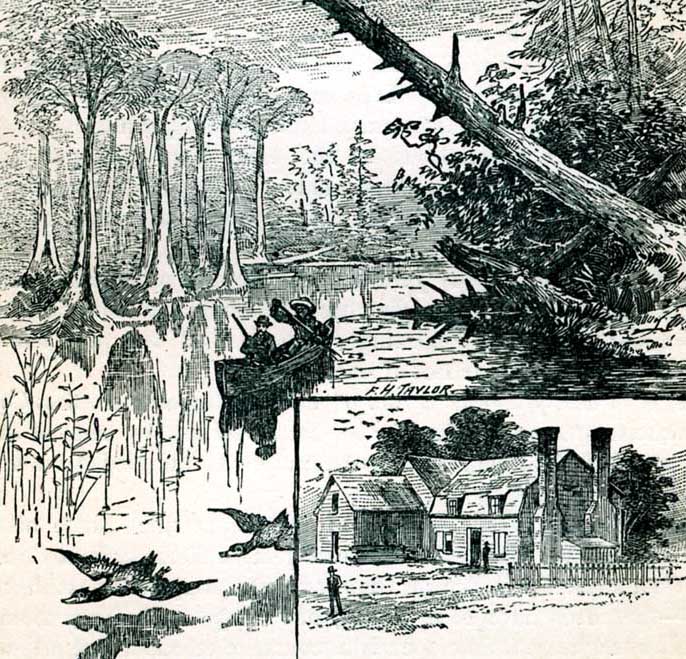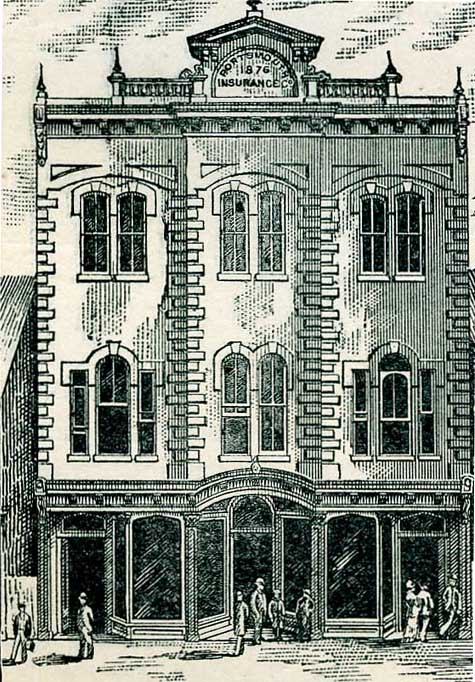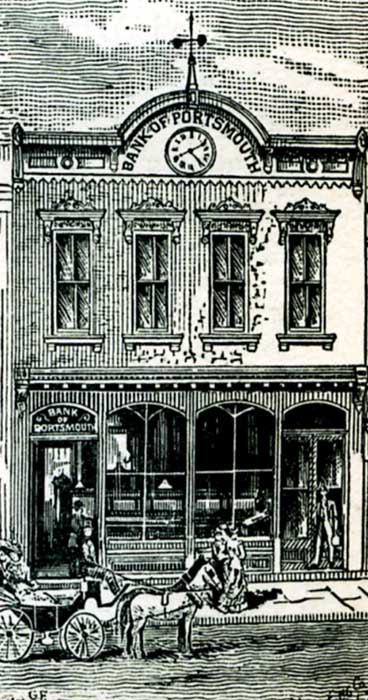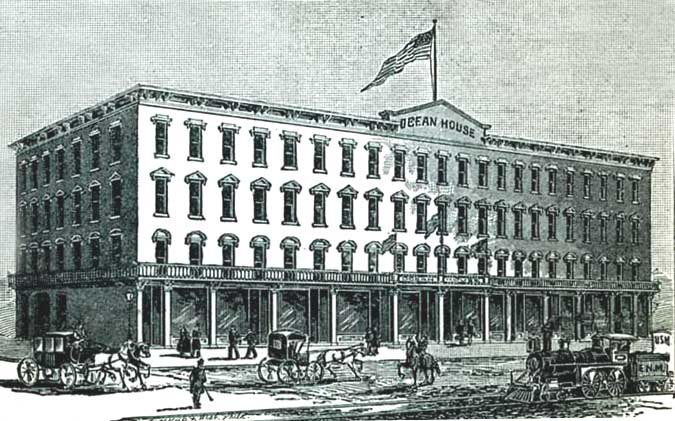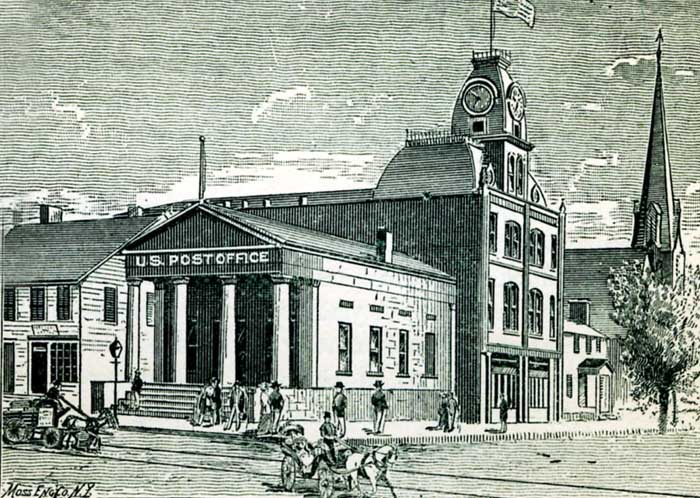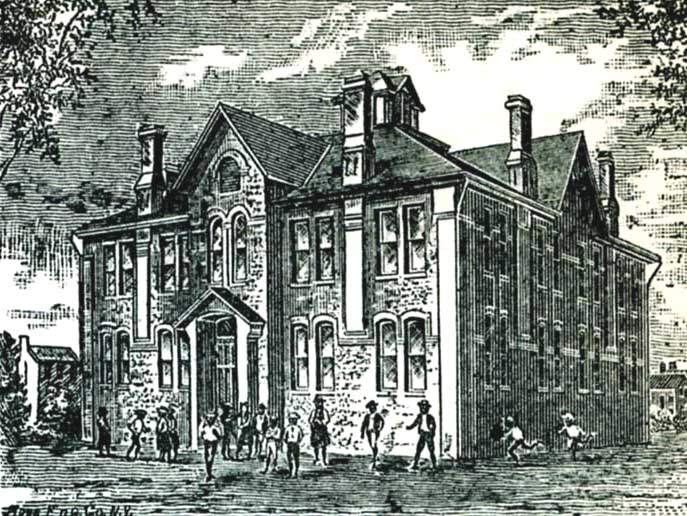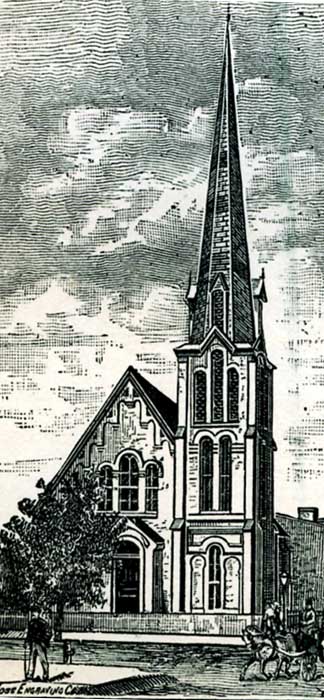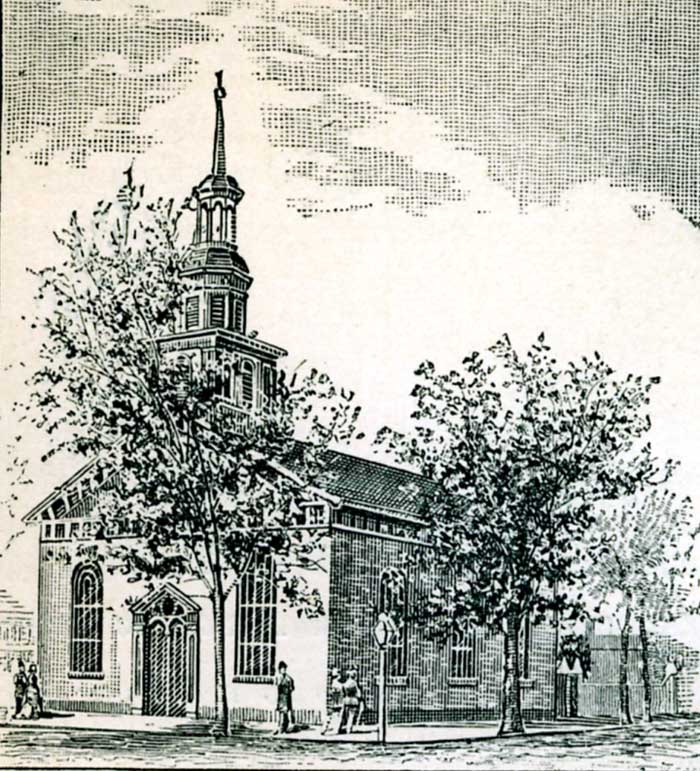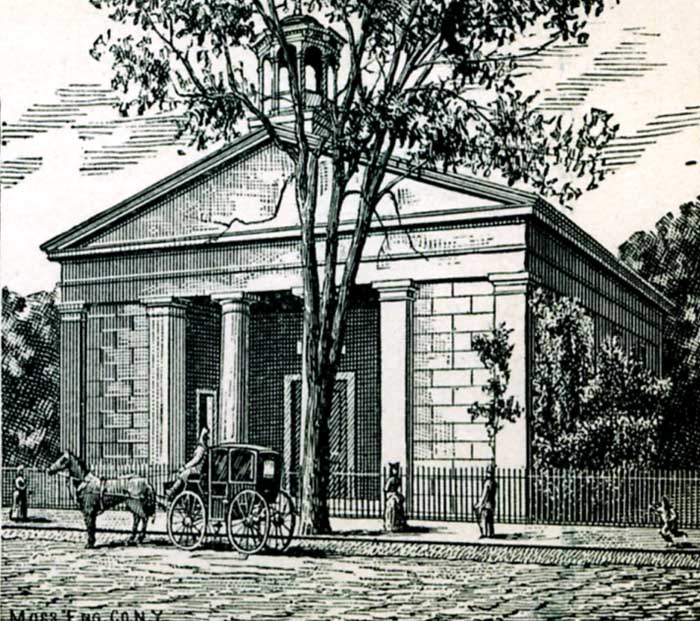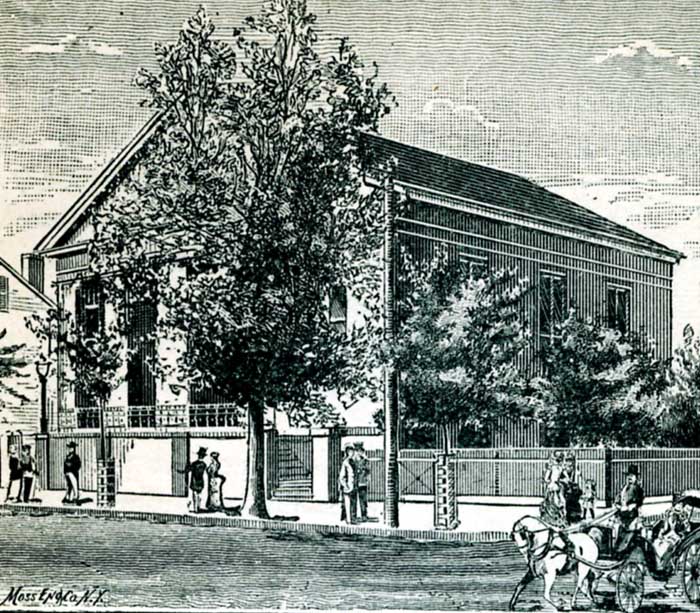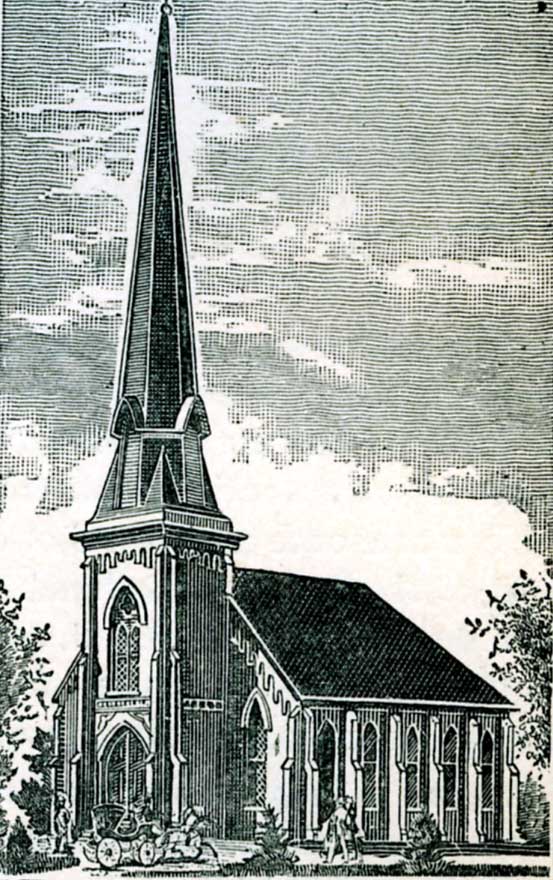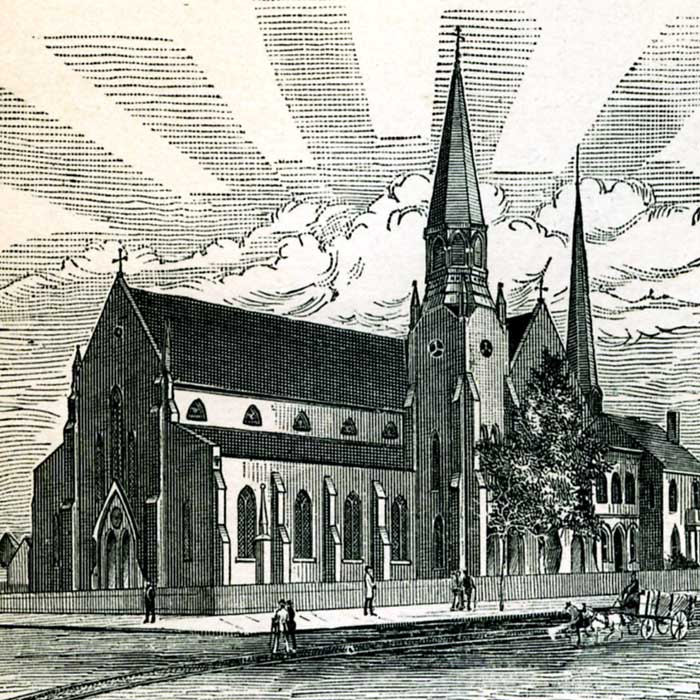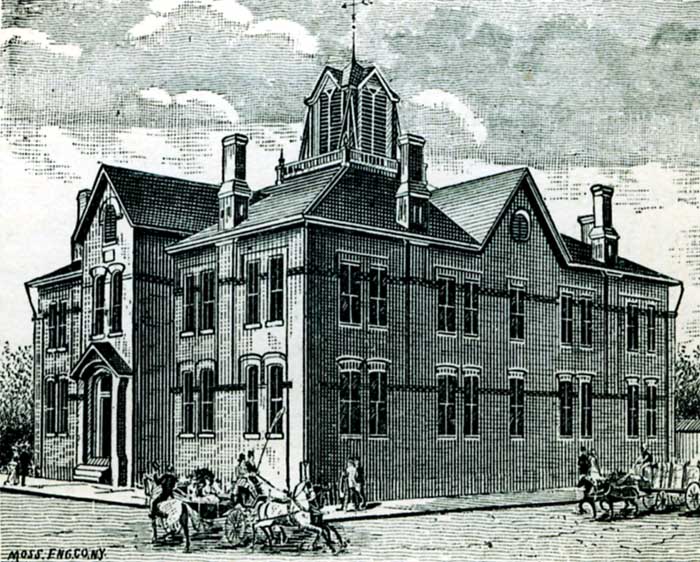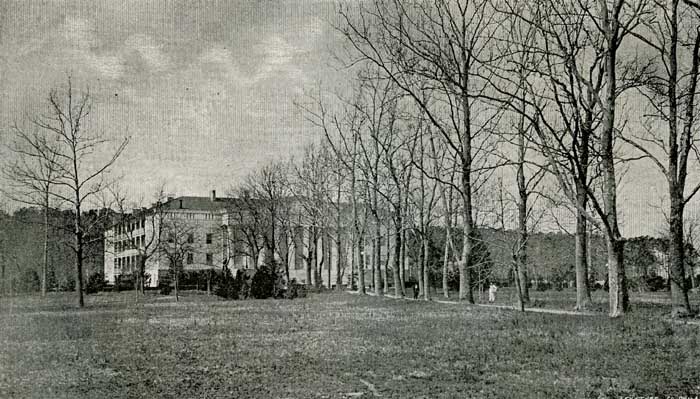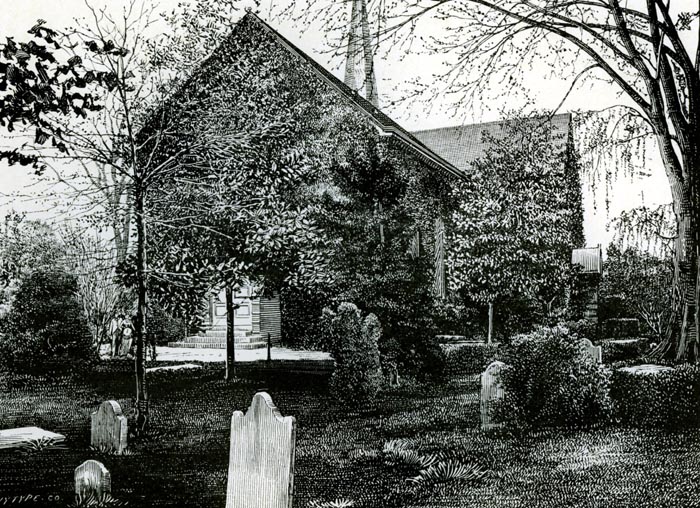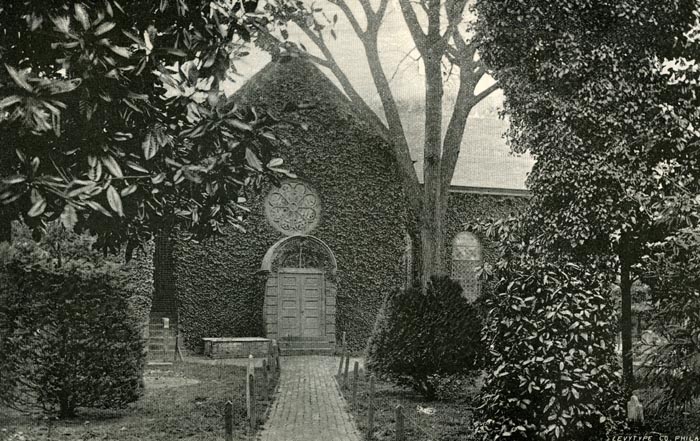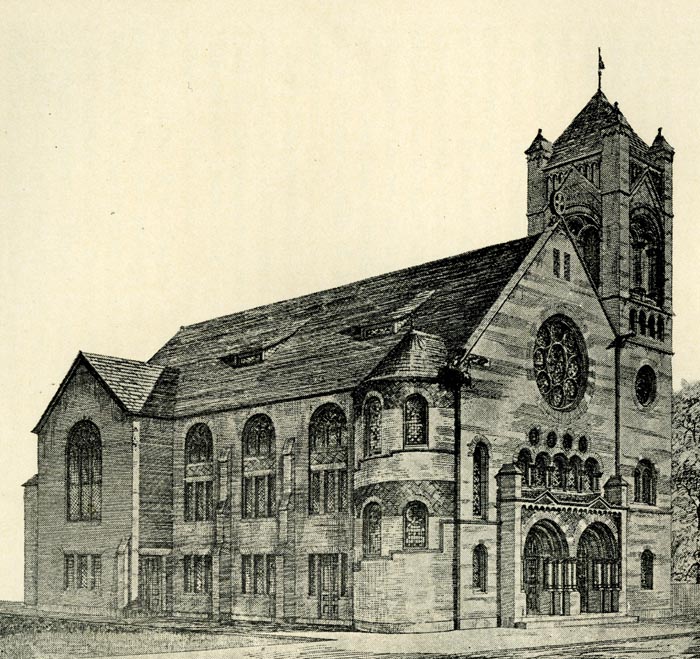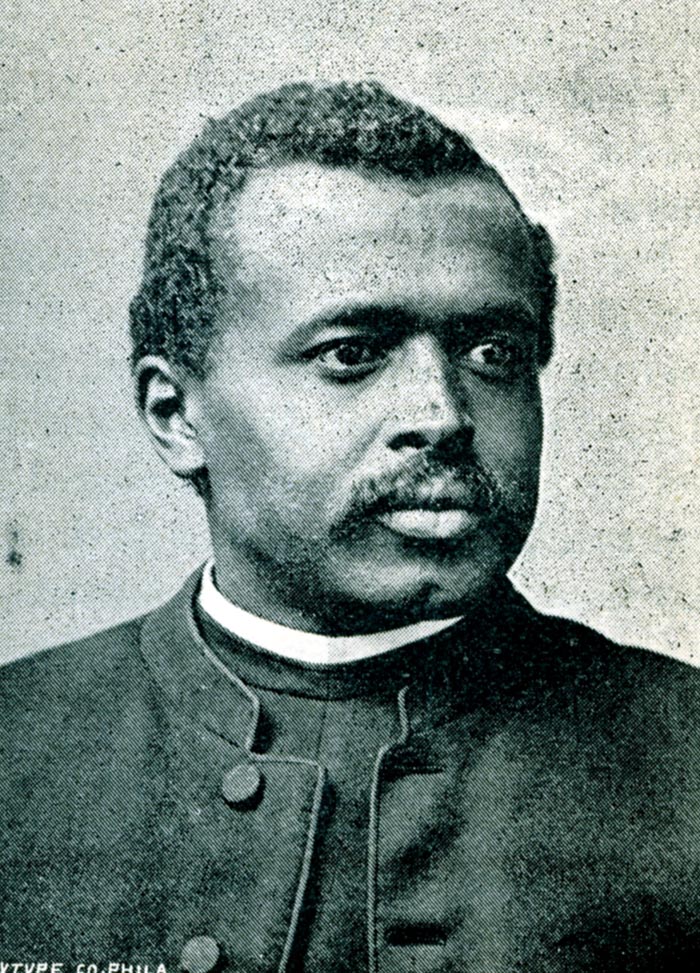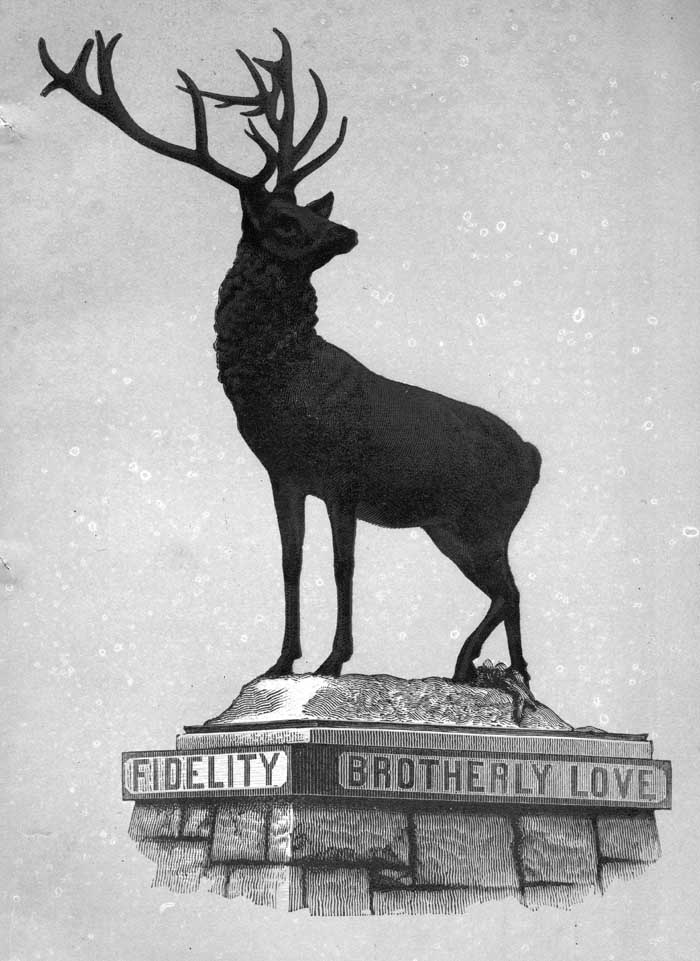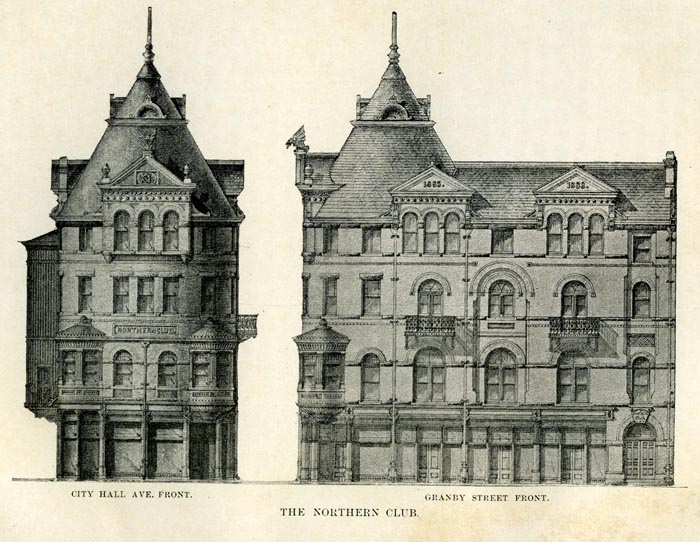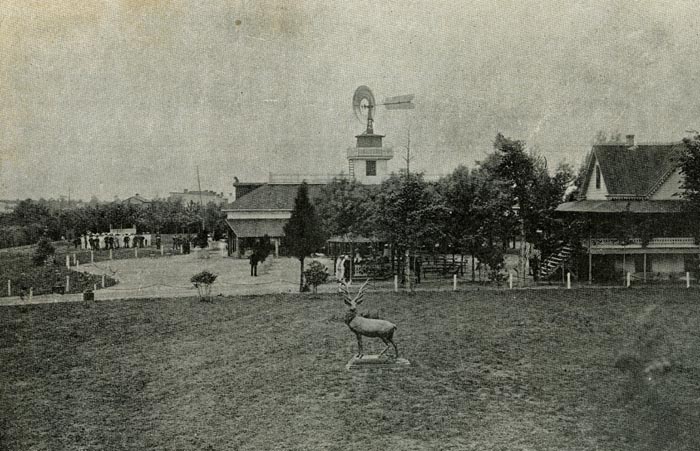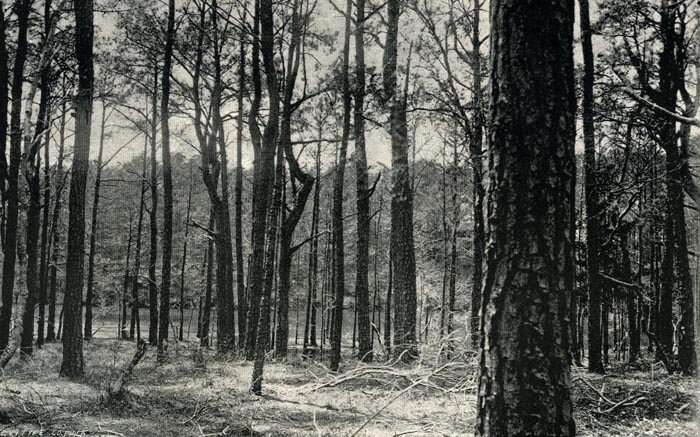OUR TWIN CITIES
OF THE NINETEENTH CENTURY:
NORFOLK AND PORTSMOUTH
THEIR PAST, PRESENT AND FUTURE.
Robert W. Lamb, Editor.
Norfolk, VA: Barcroft, Publisher.
1887-8.
Norfolk Landmark Steam Presses.Reproduced by Donna Bluemink.
Continuation.
[125] CHAPTER VI.
The Portsmouth Side of the Harbor, and Its Adjacencies.WE HAVE turned our back on Old Dismal and his lovely daughter, and if the necessities of the case required it paddled our own canoe through the Jericho cut, boarded the N. and W. Railroad train once more, and through the courtesy of its polite officials are safely deposited at the G. L. Roper Lumber Co.'s works, where the small steamer which is to convey us down the harbor awaits us. Now we are sailing down stream with our eyes wide open to the beauties and advantages of the left or eastern side of the Southern Branch.
For some distance there is little of general interest. The land on this shore, both sides of Paradise Creek, which here flows into the river, belongs to an old resident. Dr. William Schmoele, Jr., and as yet awaits the great expectations—perhaps the great possibilities—of the near future. We feel assured that our neighborhood is approaching a climax when the cities of our common harbor must either retrograde or improve rapidly; and we are unwilling to believe that our people will be so blind to their own interests as to remain supine and permit the golden opportunities now offered them to slip away unimproved.
Our attention is again attracted, as we near the mouth of Back Creek, by the improvements of Nottingham, Wrenn and Styron, whose enterprise, as already noted, has done so much to advance the interests of Atlantic City. Here they have a factory for fertilizers and shell lime and an extensive lumber and shingle wharf.
But we are soon out of the range of private enterprise and have reached a locality of great general interest, whose ante-bellum title was the " Gosport Navy Yard," after the district of Portsmouth in which it is situated, but is now generally known, even in official circles, as the Norfolk Navy Yard.
As this is a subject which may prove of interest to many of our readers who have never been reached by the work itself, we quote freely from "A History of the United States Navy Yard at Gosport, Va.," by Commander Edward P. Lull, U. S. N., which was published in 1874:
"No Navy Yard belonging to the United States is from its geographical position more important than that of Gosport, Va. Located near enough to the entrance of Chesapeake Bay to be easily accessible, it is, at the same time, in a position readily defended from attacks either by land or by water, and one, as has been repeatedly shown, which can be held by [126] a small force against a very largely superior one. There is in the vicinity an abundant supply of timber and other material, while the close proximity of a populous city secures to it the command of all the skilled labor that can be required. Such is the mildness of the climate that work of all sorts can be carried on at all seasons of the year without interruption. Hampton Roads, the outer harbor, is an excellent point of rendezvous for a fleet or squadron.
"A glance at the map will demonstrate the very great importance of a naval station in this vicinity. The Chesapeake, with its navigable tributaries, penetrates into the heart of several of the richest States in the Union, reaching to the National Capital. A foothold in its waters would, therefore, be of the utmost strategic importance to an invading enemy, and would probably be one of the earliest objects sought by them, as past history has fully shown. The width of the entrance of the bay is so great that it would be impossible to defend it except by a naval force, which should have a repairing, coaling and victualing station as near at hand as possible consistent with entire defensibility for itself, with a reasonably secure outer harbor, large enough for the necessary manoeuvres of a squadron in getting under way and forming. All of these conditions are admirably filled by the location of the Gosport yard.
"Just before the War of the Revolution the British established a marine yard, for the use of its navy, on the site of the present Navy Yard at Gosport (as that part of Portsmouth has always been called), having, as is stated in a letter now on file in the Navy Department, written in 1824 by Miles King, U. S. Navy Agent, selected this point after a careful survey of all the ports within its dominions in North America, as the most eligible situation for a naval station. The name of Gosport was doubtless taken from Gosport near Portsmouth, England, where one of the most important of the British dock yards is located. There is a tradition that this spot had been used for some time by the British as a careening-ground for their ships, but the writer has not been able to find any proof of the fact. Mr. King's letter further states that scarcely had the British Government commenced its works for the completion of the naval establishment, when the Revolution began, and the yard, together with the adjoining property of Andrew Sprowle, the British Navy Agent, became confiscate and forfeited to the State of Virginia.
THE FIRST VIRGINIA NAVY.
"Virginia immediately commenced preparations for establishing a navy, and vigorous measures were adopted to that end. Several vessels were built or purchased. A ropewalk was established, which was probably at Gosport, though it is not certain. The published histories of Virginia and of the United States Navy are alike singularly silent upon the subject of the Virginia Navy. The most that the writer has been able to find have [127] been the acts of assembly authorizing its creation, subsequent additions and changes, and its final abolishment.
"The Virginia Navy was employed mainly for the defense of the bays and rivers of the State. Commodore Barron was appointed its Commander-in-Chief, being styled 'Commodore of all the armed vessels of the Commonwealth.' His two sons, Samuel and James Barron, and also Richard Dale, all afterwards distinguished officers of the United States Navy, served under his command. At the conclusion of the war the State Navy was disbanded.
SALE OF GOSPORT.
"By an Act of the General Assembly of Virginia, passed in May, 1784, Joseph Jones, Paul Loyall, William Lee, Mann Page, Benjamin Harrison, Thomas Nelson, Miles King, Henry Tazewell and John Kearnes were appointed commissioners for the sale of certain public lands belonging to the Commonwealth, among which were the lands commonly called Gosport, adjoining the town of Portsmouth, except such part thereof as in their opinion might be necessary for the use of the public, taking care to lay off the said lands into lots, so as to make them uniform with the town of Portsmouth.
"It seems that the commissioners above named never procured a meeting of a sufficient number to act, in consequence of which the law was amended in October of the same year so as to place the appointing of the commissioners in the hands of the Governor, by and with the advice of the Council; and the commissioners were empowered to sell such portions of the Gosport lands as the Governor and Council should direct, after having laid them off into lots and convenient streets. The persons appointed and who acted as commissioners for the carrying out of the law were William Ronald, Edward Carrington and Benjamin Temple.
"The marine yard was retained for the benefit of the Commonwealth, though no use is known to have been made of it until the year 1794. The lands adjoining the yard were sold in 1785. A large portion of them, in addition to the yard, was afterwards purchased by the United States.
"In a report submitted to the House of Representatives by Secretary Knox, under date of December 27, 1794, after stating the character, armament, etc., of the vessels ordered, the materials to be used and how to be obtained and prepared, he goes on to say that in order as well to distribute the advantages arising from the operation as to ascertain where the work could be executed to the greatest advantage, the building of the ships had been ordered in six different ports of the Union; one of the ports selected was Portsmouth, Va., where a frigate of 44 guns was laid down.
* * * * * * * * * *
"The marine yard at Gosport was lent to the Government by the State of Virginia, and, as will be seen further on, it was not purchased by the [128] United States until several years later. Capt. Richard Dale was appointed superintendent of the yard, Josiah Fox naval constructor or master builder, and William Pennock navy agent.
"The breaking out of the war with France in 1798 gave a fresh impetus to the infant navy, and considerable sums of money were appropriated by Congress for building, purchasing or hiring vessels to be used against that republic.
"In July orders were sent to Mr. Pennock to recommence work on the frigate at Gosport, for which the name Chesapeake had been chosen. During the same month a brig of 200 tons which had been built near the Navy Yard by Mr. Herbert, and which was nearly ready for launching, was purchased by the Government and fitted out under the name of the Norfolk.
"Considerable activity prevailed in the yard during the remainder of the year. A brig was purchased by the citizens of some of the principal towns of Virginia, and presented to the Government. It was named the Richmond, and was fitted out under the command of Capt. Samuel Barron, who had served in the Virginia Navy during the Revolution. The vessels of Commodore Truxtun's squadron frequently resorted to the yard for repairs and supplies and to pay off their crews. The yard was also made a depot for the supply of masts and spars to cruising ships, and even to vessels fitting at Baltimore and Philadelphia.
"The importance of the Gosport yard, particularly as an equipping, recruiting and victualing station, had now become so well established that the Secretary of the Navy resolved to make it one of the permanent navy yards of the country.
"January 24, 1801, $12,000 were remitted to Mr. John Hopkins, of Richmond, Va., to be paid to the State, as the purchase money of the Gosport lands, and under date 15th June, 1801, a deed was executed by Governor Monroe, by which the title and jurisdiction of the property were conveyed to the United States.
"In October, 1801, a marine guard was sent to the Gosport Yard, and the Navy Agent was directed to furnish them with quartets.
"In April, 1802, Mr. Pennock recommends the building of a storehouse for provisions, etc., within the yard. Up to that time private warehouses had been hired for the use of the navy stores.
"April 26, 1802, Mr. Pennock was removed, and Daniel Bedinger was appointed Navy Agent and Superintendent of the Navy Yard.
"In April, 1803, $10,000 were sent to Mr. Bedinger to build a warehouse and timber-shed at Gosport.
"August 6, 1804, an order was sent to Mr. Bedinger detaching the marine guard from the Navy Yard and ordering it to Washington.
"During the summer of 1806 we find several gunboats and ketches fitting out and laying up, under the direction of Lieut. Arthur Sinclair.
[129] "On the 28th of November, 1806, Capt. Stephen Decatur was. ordered to superintend the building of four gunboats at Gosport. In July, 1807, Mr. Bedinger was ordered to contract for materials for ten additional gunboats, and a little later to contract for building the same. Capt. Decatur was ordered to superintend the construction. * * *
"July 7, 1810, the Department having become tired of the practice of operating the Navy Yard under irresponsible civil administration, ordered Commodore Samuel Barron as Commandant of the yard, the gunboats, the officers and men. Commodore Barron had scarcely entered on his command when, on the 29th of October, 1810, he was overtaken by death.
"In May, 1811, Capt. Samuel Evans was ordered as Commandant, and from that time we find lieutenants, masters, medical officers, boatswains and gunners attached to the yard and to the vessels in ordinary. Capt. Evans continued in command until August 10, 1812, when Capt. John Cassin was ordered to relieve him.
" In September, 1818, Capt Arthur Sinclair was ordered to this Navy-Yard to superintend the construction of the Delaware, under Capt. Cassin. We find about this period, and for some years after, considerable quantities of timber, plank, knees, masts and mast-pieces, and also of cordage, furnished from Gosport to the navy yards in other parts of the country.
"In June, 1821, Capt. Cassin was relieved by Capt. Lewis Warrington. In August, 1821, a school for midshipmen was established under the charge of Chaplain David P. Adams, on board the Guerriere, frigate.
"In December, 1826, Capt. Warrington was relieved from the command of the yard by Master-Commandant James Renshaw.
"On the 25th of May, 1824, the Senate of the United States passed a resolution calling upon the Secretary of the Navy for information upon the following points: 1st. The expediency, usefulness, economy and necessity of a dry-dock of sufficient capacity for receiving, examining and repairing ships of the line. 2d. The best location for a dry-dock.
"The Hon. Mr. Southard, then Secretary of the Navy, in his answer to the resolution, under date of January 3, 1825, urged in very strong terms the necessity not only of one but of at least two dry-docks for the Navy, at its then present size. In regard to the location, he quoted the opinion of the Navy Commissioners, that there should be one in the eastern part of the Union and one in the waters of the Chesapeake. For the site of the first of these he proposed Charlestown, Mass., and for the second, Gosport.
"The work upon the dry-dock was commenced in November, 1827. Col. Baldwin was appointed engineer in charge of the construction, and Capt. W. P. S. Sanger was appointed resident engineer at Gosport. Capt. Sanger continued in the immediate charge of the work under Col. Baldwin until its completion.
THE FIRST LINE-OF-BATTLE SHIP BUILT AT GOSPORT.
"On the 17th of June, 1833, the anniversary of the Battle of Bunker Hill, the dock was opened for the reception of the line-of-battle ship Delaware, the first liner built at Gosport, and the first national ship ever docked in a dry-dock belonging to the United States. The line-of-battle ship North Carolina was soon afterwards admitted to the dock.
"The dry-dock was turned over to the Commandant of the Navy Yard complete on the 15th of March, 1834. The total cost of the work was $974,356.65.
"On the 26th of August, 1846, the lot of ground opposite the Navy-Yard, and known as St. Helena, was purchased and added to the yard. This ground was needed for ordnance purposes. Jurisdiction of the St. Helena property was ceded to the United States by an act of the General Assembly of Virginia, dated March 22,1847.
"Commodore Lawrence Kearny became Commandant on the 1st of June, 1847. Some progress was made that year upon the launching-slip. The frigate St. Lawrence and the brig Perry were launched. The former had been on the stocks for over twenty years. The steam frigate Powhatan was laid down. January 19, 1848, Commodore John D. Sloat was ordered to relieve Commodore Kearny as Commandant.
"Between the years 1850 and 1860 great progress was made in improving the yard, under current appropriations, while at the same time great activity prevailed in building, repairing, fitting out and laying up the ships and vessels of the Navy. The steam frigate Powhatan was launched in 1850. Gas for lighting the yard and buildings was introduced in 1855.
"In 1855 the magnificent steam frigates Roanoke and Colorado were laid down. These vessels were finished and launched in 1857. The steam sloops Dakota and Richmond were begun in 1858 and launched, the former in 1859 and the latter in 1860. A purchased steamer called the Dispatch was rebuilt in 1859 under the name of Pocahontas."
Subsequent to this latter date the history of the yard becomes merged into the history of the war between the States; and the remarkable evacuation and surrender of this important work (April 20,1861), accompanied by the destruction of much valuable property, including the following men-of-war, wholly or in part, the Pennsylvania, three-decker, 120 guns, the receiving-ship of the station; the Delaware, 74; the Columbus, 74; the frigates Merrimac, Columbia and Raritan; the sloops-of-war Germantown and Plymouth, and the brig Dolphin, are events with their consequences too well known to require further presentation to our readers.
Subsequently (May 10, 1862) the Confederates in turn gave up the coveted prize, and Admiral Goldsborough, who commanded the Federal blockading squadron, thus reports his arrival at Portsmouth and the de- [131] struction effected by the Confederate troops before their departure, under date of May 12,1862:
"I accompanied the President [Lincoln] and Secretaries Chase and Stanton yesterday to Norfolk, on board the Baltimore, but I did not return with the party [to Fortress Monroe].
"In the afternoon I visited the Navy Yard [at Gosport] and went all over it. It is still burning in many places. Nearly everything is destroyed. Of the buildings, the officers' quarters alone remain intact. The dock-gates are all destroyed, and the pier-ends connected with the gates have been blown up to a partial degree, but otherwise the dock itself seems uninjured."
"Admiral Goldsborough took possession of all the naval property in the vicinity, including the yard, the magazine and the Naval Hospital.
"On the 20th of May, 1862, Captain John W. Livingstone was ordered to the yard as Commandant. He at once commenced the work of putting the yard in as good order as its ruined state would permit.
"Considerable appropriations for the fiscal years ending July, 1865, 1866 and 1867, respectively, were made by Congress for restoring the various workshops, stores, wharves, cranes, shears and machinery in the yard.
"The restoration of the yard has been steadily progressing under the current appropriations. Dredging has been carried on from time to time, and is going on now, for deepening the channel off the yard, the design being to gain twenty four feet of water at least.
"It is earnestly hoped, in view of its great importance, that Congress will make such appropriations for the continued improvement of the yard at Gosport as shall make it commensurate with the needs of a first-rate naval power."
This brings the Navy Yard up to 1874, after which little of special interest occurred. Under the able management of the present Commandant (Commodore Geo. Brown), however, great improvements have been made—the roads have been graded, new shops built, large storehouses erected, a magnificent new dock is in course of erection, and preparations are being made to lay down ships of the latest and most approved types for our new navy.
Anchored off the Navy Yard is the receiving-ship Franklin, one of the finest of the old style of wooden frigates, which is now under the charge of Capt. A. P. Cooke, U. S. Navy.
The Marine Barracks, under the charge of Maj. McLane Tilton, U. S. M. C., is located within the Yard, and the garrison is kept in the highest state of discipline and efficiency.
In closing our remarks on the subject we can only heartily endorse the wish of Commander Lull and trust that an enlightened policy, unhampered and unbiased by political influences and [132] prejudices, may do full justice to this very important Government work.
Turning our back upon Uncle Sam's special province we enter once more upon the field of private enterprise, as we glide by the wharves of Portsmouth, stopping only to cull out such objects of special interest as attract our attention en route down the harbor.
We come now to speak of the city of Portsmouth, which embraces within its corporate limits, between Swimming Point Creek on the north and the U. S. Navy Yard on the south and the Elizabeth River on its eastern front, some 650 acres and a population not less than 12,000.
Dismal Swamp and Suffolk Farmhouse.
As we pass down the river from our visit to the Navy Yard our attention is first drawn to the very valuable wharf property and warehouses of the Peaboard Compress Co., which only awaits proper development at the hands of capital to make it still more valuable and to give that busy air and life to this portion of the water front of our sister city which the unfortunate accidents and occurrences of three years ago, already referred to at length in our Historical sketch, have almost completely deprived it of.
Active industries in the shape of oyster-packing houses, a saw mill and several flourishing coal and wood yards next merit notice before we reach the depot of the Seaboard and Roanoke Railroad.
This road, to which reference has already been made as a great trade [133] feeder, furnishes a delightful passenger route, with its connections to all points of interest in North and South Carolina, Georgia and Florida.
To those who have not visited with us the Dismal Swamp and Lake Drummond via the N. and W. Railroad another opportunity to see this wildly romantic spot, which well repays some fatigue, is offered by a short and pleasant run up to the thriving town of Suffolk on the S. and R. Railroad, where the hospitable and accommodating landlords are always happy to take the best of care of their visitors and afford them every facility of seeing the wonderful sights in their vicinity and frequently giving them a taste of bear meat captured from the "Great Dismal."
Presuming that our invitation is accepted, we will take the morning train on the S. and R. Railroad as we pass up High street, the principal thoroughfare of our city, note some of the buildings which catch our eye in rapid transit, and perhaps linger over some, with an author's license, longer than is strictly compatible with railroad speed—in fact, taking the liberty of stopping the train, getting out for an inspection and even wandering off into the neighboring streets when we think the interest demands it, resuming our trip by rail at a more convenient season.
The stranger visiting Portsmouth, especially after leaving her sister city with the narrow irregular streets, cannot fail to be favorably impressed with the elegantly wide, straight thoroughfares that greet his eye and satisfy his taste; nor are handsome buildings wanting to add to the pleasing effect as we pass up High street. There is only lacking that busy stir, that eager pressing throng of active men and women battling for bread and striving for mastery—the want of which is even more apparent from the ample space here found for life's battle. We believe there are great future possibilities here— opportunities that await the hand of enterprise in the near future—and that it is near we think the improved surroundings, the new line of street cars, the electric lights illuminating the streets and other lesser evidences of enterprise clearly indicate. But truth must be told; and with all due respect to our sweet sister of the southern side, her placid bosom is not as much disturbed by the active emotions of business life and energy as we could wish to see it. But we repeat it—the dawning of a near future is at hand, and then our elder sister may have to look to her laurels. Nous verrons.
[134] We have already alluded to the handsome Kirn building, whose upper floor is now graced by the rooms of the Y. M. C. A. of Portsmouth, which has sprung into life, and useful activity almost by magic—or we should perhaps say by a miracle. But when earnest, true men work together in our Father's cause, aided by noble and beautiful women, there is no human limit to the good and beautiful effects that can result therefrom.Without wishing to discriminate between the attractions that meet our eye as we pass up the street, we must note, however, the fine buildings of the Bank of Portsmouth and the Portsmouth Insurance Company, two old and well-established institutions, as our artist has seen fit to make them subjects of illustration.
As we approach the corner of Court street, a thoroughfare even more attractive to the stranger's eye, we think, than its more business neighbor, we reach a very centre of attraction, where memories of the past, future hopes and present realizations all mingle to seize and hold our interest.
It seems remarkable that so attractive a hotel, so far as its externals can indicate, as the Ocean House (which is the handsome building shown in our illustration below), located on the northeast corner of High and Court streets, should not have been better patronized from time to time under its several managements, which have really been worthy of better success if public report is to be credited.
The past experience, however, of her elder sister, Norfolk, in this line is well known. How many years the struggle was kept up before the hotel business in that city attained the success and well-earned reputation which it now enjoys! The great hospitality of the people—proverbial, in fact—of our cities by the sea had much to do in postponing this result. This fact in connection with the admirable arrangements of our transportation lines for through travel—which prevents those delays at transfer points so agreeable to the hospitable and enterprising landlords but so harassing to the traveler in this age of push and hurry—and the very complete hostel arrangements on the Norfolk side have combined to prevent full justice being done to what should be and must yet soon be, as the coming golden day of progress draws nearer, most admirable location for a hotel, first class not only in all its appointments but also in what is very essential to keep it so—patronage.
Across the way Uncle Sam's old Letter Box still stands, quite a veteran, which will, we hope, soon give place to a more modern structure [135] and one in better keeping with its surroundings and the business demands of a community that is beginning to be thoroughly alive to its capacities and deserts.
The older sister has gotten the start in the race for this special goal, but we see no reason why the success of the one should debar the other from attaining a need long felt and generally acknowledged.
We are no partisan chronicler, but we must say that it is not reasonable to believe in the permanent success of any party, call it what you will, who under the pitiful subterfuge of retrenchment and reform endeavors to curtail judicious expenditures and introduce a niggardly economy. Give us, if need be, a high protective tariff—which will not be appreciably felt by the individual over our broad land; but keep no hoarded, useless millions in our treasury vaults—rather gladden the hearts of our working men and gratify the eye and taste of our people everywhere with handsome public buildings and other improvements that will be fruitful sources of pride and pleasure to all.
We much prefer the extravagance of rings, that brings beauty and comfort for all, though it put big money in the pockets of a few, to that so-called "economy," which is really making a very few moderately comfortable and doing nothing for the many.
Leaving the post office and turning into Court street we reach the Palace of Justice, the City Hall of Portsmouth, whose throne (?) Mayor Thompson Baird has graced, through the suffrages of his fellow-citizens, who delight to honor a faithful servant, these many years.
It would be very gratifying at this point to give the statistics of the city's finances, etc., brought down to a very recent date, but for some reason there was a failure to publish the official municipal reports of last year. Our statements must therefore be based upon those of the fiscal year ending June 30,1886—since which, however, we are informed there [136] have been no material changes. We quote as follows from Mayor Baird's address bearing date August 2,1886:
"All obligations of the city have been promptly met at maturity. The bonded debt is four hundred and fourteen thousand seven hundred dollars, which is an increase of thirty-one thousand five hundred dollars during the year.
"A full account of the bonded indebtedness of the city, the interest and maturity of each series, is found in the treasurer's report, as follows:
BONDED DEBT OF THE CITY.
First Series—6 per cent, coupon bonds, interest payable January and July, redeemable July 1, 1888 Second Series—7 3-10 per cent, coupon bonds, interest payable January and July, redeemable July 1, 1897 Third Series—6 per cent, coupon paving bonds, interest payable June and December, redeemable in 10 years from issue Fourth Series—6 per cent, coupon paving bonds, interest payable May and November, redeemable in 10 years from issue Total bonded debt "The first series of bonds were issued under act of assembly February 26, 1858 (see Acts 1857-58, p. 176), 'to retire scrip past due and payable on demand.'
"The second series of bonds were issued under act of assembly January 21, 1867 (see Acts 1866-67, p. 545), 'to redeem scrip and meet interest due and unprovided for by reason of the late war, and to erect public buildings and procure fire apparatus.'
"The third and fourth series of bonds were issued under act of assembly April 21, 1882 (see Acts 1881-82, pp. 441-443), and act of assembly March 4, 1884 (see Acts, p. 368), 'to pave and grade the streets of the city.' They were issued as the requirements of paving demanded from 1879 to 1886, and as above stated are redeemable ten years from date of issue.
"This increase of the debt is insignificant when we note the large sums which have been expended in material and lasting improvements for the benefit of ourselves and for posterity.
"It is complimentary to the financial management of the city that you have been enabled to reduce the tax on real estate and personal property twenty cents on the hundred dollars valuation, the tax being now one dollar and thirty-five cents, as against one dollar and fifty-five cents last year. Our ability to do this in the face of the almost total suspension of employment in the U. S. Navy Yard and the severe financial storm which swept away so much wealth, makes it also evident that the enterprise of the people has been stimulated to build their fortunes on more stable ground by investment and improvements in real estate.
[137] "The most important and prominent work of improvement which has engaged our attention for the past five years is the paving of the streets. This is yet progressing in a satisfactory and workmanlike manner. Some of these streets terminate in navigable water, and nature has been inviting us for years to utilize them for our advancement. Shall we improve and develop such treasures into sources of wealth, or will we allow them to remain idle and unproductive? The piers of New York are of her most valued property. What may not ours be made unto us? Do we not lay on the centre coast of the Atlantic Ocean, and are we not the natural entrepôt for commerce between the North and the South of this great republic?
"When the genius of the practical mind rises to a perfect understanding of the geographical advantages which we enjoy by inheritance, and gives some earnest of that knowledge in substantial form, then will capital, energy and labor combine with nature and crown us queen of cities by the sea."
Noting these practical suggestions of the Mayor, we would add for the benefit of those seeking investment in favored localities and under whose observation our plain, unvarnished tale may come, that these opportunities are open to them alike with the residents of our sister city, who, not from want of enterprise so much, perhaps, as a need of capital, are tardy in realizing on their natural advantages, and, moreover, will be found a courteous and hospitable people, ready to extend a hearty and encouraging welcome to the stranger who comes within their gates seeking to benefit himself while improving their city and willing to become in truth one of them.
[138] Next to the financial condition at least, if not really paramount in interest, is the question of health. And in this respect the city of Portsmouth yields the palm to none. Exempted by its geographical situation from extremes of cold and heat, it enjoys many months of the year the invigorating sea breezes, while every precaution has been taken by its thoroughly practical Board of Health to guard those avenues against the approach of imported diseases which are necessarily more or less opened in seaport towns by their intercourse with the outer world. The president of the Board of Health in his last published report to the Mayor thus speaks of the work of the body over which he presides:"The Board of Health has been diligent in using all proper means for the promotion and preservation of the public health. Public and private nuisances have not only been abated but as far as possible they have been remedied. The market place has been kept in a good sanitary condition, and the gutters of the streets, frequently in a state of nuisance by water from pumps and private drains, have been kept clean. Marshes have been drained, low lots filled up as far as dirt has been available, and no effort spared to put and keep the city in as clean a condition as possible. The contractors for the removal of night soil and garbage have faithfully complied with the terms of their contracts, and seem to be giving entire satisfaction to the public."
The report further shows the rate of mortality of whole population, 22.9; rate of mortality of white population, 19.1; rate for colored, 30.5. To which may be added the statement of the Health Officer that the mortuary statistics for the past five years show no increase, and accounts for the larger per centage of deaths among the colored race by the significant fact that probably one-half of them die without medical attention. Further, he remarks—which is certainly gratifying and noteworthy: "With two exceptions, there is not a foreign city of the fifty examined that has as low a death rate among the whites as this city, and very few of the American cities any lower."
We cannot leave the subject of the city from what we may style a public standpoint without reference to the public schools, of which her citizens are justly proud, for they are second to none perhaps in the Commonwealth.
Without reflection upon her private schools, which have always ranked high, we note the remark of the Superintendent of Public Schools in his report to the Mayor that "Many parents and guardians now patronize those schools who formerly sent their children to the private schools. This is due to the fact that our modes of instruction, advanced grades and competent teachers are better known to the general public, and hence are better appreciated."
There are nineteen of these public schools in successful operation, occupying three handsome and capacious buildings, two of which—the [139] Green-street school for white children, for whom there is also another building, and the Chestnut-street school for the colored children—have been faithfully pictured by our artist and can therefore speak to the eye and taste of our kind readers for themselves; and we rest satisfied in anticipating a favorable verdict in their behalf and for the enterprise and energy of the worthy citizens of our sister city in the good cause of popular education.
A Chestnut-Street (Colored) Public School.
We have great faith in a certain amount of the aesthetic in the surroundings of our little people, who are to be the fathers and mothers of the future, whose good taste may help to make our homes more beautiful and happy.
As we thank His Honor for the interesting information derived from his message and accompanying reports and start out once more on our tour of inspection before returning to High street, we pause to admire the tasty Court-street Presbyterian Church, with its graceful spire, which is certainly an ornament to that portion of the town. This is the handsomer of the two churches which this sturdy and vigorous denomination, whose manly stand for the right and activity in good causes always make themselves felt in any community, has in the city. We readily accept the taste of our artist in selecting it as a subject of adornment for our story of the sister cities. Certainly in the beauty of its sanctuaries as well as of its highways our younger, sister excels its older companion. May we not hope, however, that in heart's service and faithful devotion to Him whose love should prompt the erection of all temples, whether beautiful and lofty or plain and humble, the elder sister may ever set her younger [140] a worthy example and keep her ways straight and clear though they still be narrow? On the southwest corner of High and Court streets we meet an object of special interest as a link to the Portsmouth of the olden time. It is Trinity Protestant Episcopal Church, the old parish church of Portsmouth parish, which was separated from Elizabeth River parish in 1761, and was originally built in 1762 on its present location, donated in that year by that same William Crawford of whose lands in 1752 the town of Portsmouth had been laid out. It is worthy, perhaps, of more than a passing notice—but we do not propose to play the part of historian to each object of interest that we enumerate in our tour of observation. It will suffice to say that its experience of vicissitudes was very similar to that of the old colonial churches in Virginia when the new regime which parted church and state came in.
About the beginning of the present century we find Arthur Emmerson as rector, succeeded by Rev. George Young, who ministered in this sanctuary until 1809. We mention these two as their names have been continued in Portsmouth by some of the best known and loved citizens. It was in 1821, however, after an interregnum of some twelve years, that the Rev. Mr. Wingfield took charge and for over a half-century ministered most faithfully to a loving and beloved flock. Since his death we believe there have been several changes, but the old church is still kept open, to those who still worship in the faith of their colonial fathers.
This denomination has also a less pretentious edifice on Court street — St. John's—devoid, it is true, of such historic associations, but still endeared to many by the memory of the heroic Chisolm, who was the first pastor of the new congregation, formed somewhere about 1850, whose self-sacrificing devotion, terminating in his death, during the terrible scourge of 1855, will never be forgotten by a grateful people.
Our Baptist brethren, whose special tenets are very popular in this community, have five churches, the principal of which is the Court-street church, one of the largest and most flourishing in the State Its pastor is that ripe and brilliant scholar Dr. Owen, who makes his mark and leaves a brilliant record wherever duty carries him. . Next in the number of its edifices, and probably largest in its communion, is the church which seems to take hold of the hearts of our American people generally as for the most part best adapted to the wants of the common people. We say it with due reverence and no intentional disrespect to the giver or the recipient. We refer of course to the Methodist Episcopal Church, whose beautiful Monumental Church has been selected from a sisterhood of four to embellish our pages.
In our further walk up High street our attention is once more riveted by a substantial and handsome temple to the Most High. It is St. Paul's Church, the sole representative in the city of the Roman Catholic faith, whose works, [142] while they adorn, are always substantially planted and built to stay.
There are very tender and sacred memories that cling around the name of the lamented Father Devlin of this communion, whose record during the sad season of 1855 adds a bright page to his Church's history of self-sacrifice and devotion.
But we have reached the limit of our stroll up High street, and our train, with its visitors for the sight of Suffolk and Lake Drummond, has long gone on its way rejoicing; so we wend our way to the river once more, pausing only at the northwest corner of Court street to glance casually at the enclosure which contains the Court-House and other buildings, where the public business of Norfolk county has been transacted for some years past. But as we have dwelt fully on this subject in tracing the history of our sister cities, further reference is unnecessary. At this junction of the streets stands the handsome Confederate monument whose history has been given (page 42), and on the opposite side of Court street from the County Court-House stands the Masonic Temple—one of those oases in the desert of the world's selfish work that show that all the image of his Maker is not yet entirely obliterated from the heart of man.
We reach once more the foot of High street and leave to the right the depot of the S. and R. Railroad and its wharf, where connection is made with the steamers of the B. S. P. Co. for Baltimore and cities of the North, East and Northwest—for our course lies to the northward, as we propose inspecting the river front once more.
Passing a large lumber yard we note the dock and sheds of the Portsmouth City and Norfolk County Ferry, where several street cars always await the arrival of the boats.
With a most amicable disposition and a very strong desire to present our two communities in the most favorable light, we can hardly refrain from again joining the average passenger and pitching into the unfor- [143- tunate ferry management once more. Room for improvement here, gentlemen! More suitable accommodations on the dock, more in keeping with those on the Norfolk side, and before all a boat—one real steamboat or more, that will keep up regular and efficient service for a just and liberally patronizing public.
We think, however, the problem of competent ferry service will never be satisfactorily solved until the ferries have changed hands—ceased to be in fact a political hack—and are run sufficiently in the public interest to make them so well appreciated that they will prove a handsome investment to the enterprising company who owns them and keeps them up to the mark.
The water front from this point presents a number of instances of private enterprise and sagacity in successful yards, warehouses and wharves where coal and wood, lumber and staves are handled successfully in large quantities.
There are some evidences also of shipping, but the wharves fail to present that crowded appearance which their convenience of location should demand and which the coming era will most sadly disappoint us in or certainly produce. Here is the feast; friends and neighbors from abroad, come in, sit down with us and share our plenty. Or perhaps we furnish the table and service, and you bring your viands with you.
We have now reached the splendid wharf property, surmounted by extensive warehouses, of the S. and R. Railroad. At this point connection is made with the O. D. Steamship Co., one of the links of the Seaboard Air Line, a great thoroughfare between the North and the South.
And we would here take the opportunity of specially referring to the S. and R. Railroad, its present extensive business and prospects in the [144] near future, which should all tend to the further development of our common harbor. Its early history we have given in a former chapter. Under its old name and with almost unvarying success this road has fought its way through times and tides of fortunes that its less happily constituted neighbors have had to succumb to. It is the connecting link between Norfolk and the whole system of roads throughout the South Atlantic and Gulf States, and is one of the main arteries of our trade. With its connections in the former it makes the "Atlantic Coast Line," while with those in the latter it forms what is known as the "Seaboard Air Line," which consists of the Seaboard and Roanoke, the Raleigh and Gaston, the Raleigh and Augusta and the Carolina Central. Under the same management is the B. S. P. Co, or Old Bay Line, to which reference has already been made. The president of this company also holds the same position in the O. D. Steamship Co. This road has not only a magnificent business from the interior in cotton [see Chapter IV for cotton statistics of our common harbor] but does an excellent carrying business to that section in return.
Not satisfied with the erection of immense warehouses, which had already stored several million bags of fertilizers from this market and the Northern ones, to be carried into the country from which the cotton and other crops were brought in due time in exchange, to say nothing of other articles of produce and merchandise, and the addition to their terminus on the southern side of the harbor of extensive dock facilities aggregating a frontage of 500 yards, they purchased on the Norfolk side a valuable site for a wharf and dock on an extensive scale, which they improved in keeping with the advanced business ideas of the day.
Nor is it alone at this terminus of the line that the system of which this road is but a small section is making progress. This management controls the intermediate road between the Piedmont Air Line and the coast line of railroads, taking it to Raleigh via Hamlet on the S. C. line; the Carolina Central road from Wilmington to Charlotte, through Hamlet, and a connection to Cheraw and Chester, S. C, thence to Newberry. It was thus prepared to strike a decisive blow not only to regain lost ground but even advance into the territory of its formidable rival, the Piedmont Air Line, thus dividing its splendid cotton trade and bringing it to its natural outlet—our harbor.
This connection, with all its lines complete, will make, next season, probably, almost an air line between Atlanta and our harbor through a section prolific of cotton.
It is evident, therefore, that this road is a most important factor in the development of our business and must become even more so. But it rests with our people by pluck and energy to determine whether this business shall be ours in fact or merely through business, despite of which we may sink into an insignificant way station of a great through system.
[145] It is reported, in this connection, that the Richmond and Danville Railroad or Piedmont Air Line system has begun to feel the necessity of securing the advantages of our port and therefore proposes to get possession of the Atlantic and Danville Railroad, now pushed through to Franklin, as soon as it reaches Danville, and thus have a connection of their own through to deep water in the harbor of our sister cities.
We of course feel a deep interest in the success of our old friends, who have had much to do in our improvement up to this point, but as we feel there is a large margin of progress left us we hail with pleasure all healthy rivalry that must tend to hasten this most desired consummation.
There is perhaps little to add to our sketch on this interesting subject; though were we to follow it up in all its ramifications, volumes might be written presenting many subjects in a new light.
It may be a fact of general interest, however, that should not be omitted, that the value of the real estate in the city as reported by the commissioner of revenue is about $3,500,000, and the personal property nearly $400,000, thus closely approximating a total of $4,000,000 taxable property.
The amount invested in business of all kinds will very nearly aggregate $1,250,000; while the average annual sales, as far as we can ascertain from the best sources of information, will certainly exceed $5,000,000 and may probably reach $5,500,000.
There are two solid, well-conducted banks, chartered under the State law, with ample capital to meet the requirements of business as at present conducted, though of course with an enlarged field this demand will increase.
The business now done in this city appears certainly to be a healthy one, as we note the absence of any great number of failures. The large crops of the trucking farms in the vicinity bring in considerable deposits and a large trade to this city. Of its future we do not propose to speak at length; we have tried to present its attractions and advantages to settlers; our own people already know them and should not be slow to avail themselves of them. But will they? What does the past say? Are we not too well contented with a pleasant, easy mediocrity?
It is a matter now of only a few weeks when the ample supply of excellent water from Lake Kilby will be available for all purposes, and one great drawback to the establishment of manufactories will be removed. Then comes a golden opportunity. Good friends of our younger sister city by the sea, we pray you, avail yourselves of it. Let the mills be grinding—slow even, but surely—industry and energy hand in hand grinding them—and the white-winged birds of commerce be fluttering to and fro—and sure, swift, substantial wealth and prosperity await you.
But once more we leave the haunts of business activity, and, passing down the river, find ourselves again at the wharf of the U. S. Naval Hos- [146] pital, and this time with leisure enough on our hands to pursue and investigate its beauties as we enjoy a stroll over its building and grounds.
Owing to its size and picturesque situation the U. S. Naval Hospital forms the most interesting and imposing object on the western shore of the Elizabeth River. It is located at Portsmouth, nearly opposite the city of Norfolk, in 36" 51' north latitude, 76" 19' west longitude, on a tract of level woodland, part of the great pine forest that once covered the whole of Norfolk county.
The harbor of Portsmouth is the finest on the Atlantic coast, having a depth of water at this point sufficient to float vessels of the largest size. It was explored by Morquez as early as 1573, and by Ralph Lane in 1586; but of the early settlements upon its shores little is known. In 1587 Sir Walter Raleigh sent out "one John White [as Governor], with twelve trusty counsellors," directing them to "plant themselves at the towne of Chesapeakes" (near the present city of Portsmouth); but this order was not obeyed, and no permanent settlement was made until after the founding of Jamestown, in 1607.
From this time the history of the struggling settlers was one of hardship, privation and bloodshed until 1629, when William Claiborne, known in history as "the champion of Virginia," and "the evil genius of Maryland" (who was then "Secretary of State"), defeated the Indians at the battle of Candyack, near West Point, and for a time gave peace to the colony. He was rewarded for his success by subsidies of tobacco and grants of land; and Kecoughtan (now Hampton, near Old Point Comfort, the site of the Soldiers' Home) was made his principal plantation. From this point he made "voyages for discoverie" in the Bay of Chesapeake and up the James and Elizabeth Rivers, until 1630, when he "discovered, settled and purchased" from the Indians the Isle of Kent, nearly opposite the present town of Annapolis. This famous isle became the bone of contention between Claiborne* and Lord Baltimore, and for fifty years kept the two colonies of Virginia and Maryland in dissension.
* The complications arising from this contest form, says Esten Cooke, "the most interesting part of Virginia history." Claiborne, who was proud and haughty, regarded Baltimore as a novus homo, and as an intruder upon the rights of Virginia (which he defended against the encroachments of the Maryland Proprietary); but he never recovered his Isle of Kent, nor Virginia her "Terra Mariœ." Through the influence of his kinswoman the eccentric Anne Clifford, Countess of Dorset and Pembroke, Claiborne was appointed in 1621 "Surveyor of the Colony," in 1625 Secretary of State for Virginia, and in 1642 "Treasurer of Virginia for life." He died in New Kent county in 1676.—See "Virginia" (Commonwealth Series), by J. Esten Cooke, and Appleton's "Cyclopedia of Biography," 1887.
Prior to the Revolution nearly all the lands on the south and southwestern side of the present Hospital, including the city of Portsmouth, belonged to the families of Crawford, Veale, Purcell, Butt and others, some of whom were appointed in 1763 "Directors and Trustees," with instructions "to lay off and survey the new town of Portsmouth." In [147] 1783 the trustees were authorized "to sell the lots lying on the back part of the town of Portsmouth formerly called Gosport," upon which land the Navy Yard was afterwards located. In 1819 the "Trustees of Portsmouth" were made a corporate body, and in 1858 the town of Portsmouth was raised to the dignity of a city. Up to the time of the Revolution the present site of the Hospital formed part of the primeval forest, but toward the close of the century that part known as Fort Woods was partially cleared for military purposes. Fort Nelson was erected and strongly fortified, the southern side of its outworks extending to the north front of the present Hospital. In July, 1776, Lieutenant Bentley and twenty-five men were engaged in erecting fortifications near Fort Woods*. Great Bridge, a few miles distant, was also strongly fortified, and here a battle was fought in December, 1775, in which the British lost heavily, and the Americans "lost not a single man."
* See Spottswood's Letters, Va. Hist. Soc.
In 1781 the traitor Benedict Arnold made Portsmouth his headquarters, and his men occupied the fortifications in and around Fort Woods. So great had the strategic importance of Portsmouth and its vicinity become, that after the Revolution steps were taken to secure a site for a repairing and victualing station at that point, and the old British repairing yard at Gosport was selected for the purpose and retained for the use of the Commonwealth of Virginia. In 1794 the old yard was loaned to the United States, and a fine frigate of 44 guns was laid down; but on the establishment of peace in 1796 work was suspended upon the ship until the breaking out of the war with France, in 1798, when the Chesapeake was ordered to be completed. In June, 1801, the Navy Yard, with the adjacent land covering 82 acres, was purchased by the General Government for $12,000, and in 1810 it was placed under the charge or command of Commodore† Samuel Barron, U. S. Navy. From this time until 1828 the sick and hurt of the station were treated in the Post Hospital of the Navy Yard or were transferred to the North for medical and surgical treatment. The inconvenience of this plan and the cost of transportation decided the Board of Navy Commissioners to establish a general hospital in proximity to the naval station. The land adjoining Fort Nelson was chosen for the purpose, to which was added 61 acres known as Fort Woods—purchased in November, 1827, for $9,000 from Thomas Newton and Margaret his wife; but of the original Government reservation of over 200 acres, but 75 acres remain.
† Captain was at this time the highest rank in the American Navy, but officers in command of squadrons received the honorary title of Commodore. In 1861 the grade of Commodore, with the relative rank of Brigadier General, was created.
In 1828-9 the present imposing structure of freestone and granite was commenced. It was designed and built by Mr. John Haviland, of Philadelphia, and after many interruptions all the buildings were finished, at an [148] estimated cost of $2,000,000—$600,000 being expended upon the Hospital alone. It is an immense quadrangular edifice of three stories, with verandas and courtyard, and with a splendid facade of ten Tuscan columns, whose massive proportions and imposing appearance make the Hospital the most prominent landmark of the river. It has accommodations for over 600 patients, and though not built in accordance with the modern principles of hospital construction it has been adapted to present needs and would make an excellent Home for disabled seamen.In 1829 the grounds were beautifully laid out with walks and avenues of oaks, cedars, lawn trees and shrubbery. Fresh figs and cherries were plentiful, and the woods were filled with wild grapes, blackberries and chinquepins. The water front supplied fish, oysters and clams, and the markets of Portsmouth were abundantly supplied with meats and vegetables of every kind. The Hospital was surrounded by a substantial brick wall, and a cemetery, similarly enclosed, was established about 200 yards in the rear. The residence of the medical officer in charge was then situated on the south side of the Hospital, near the head of the sea wall, and was the house of the former commandant of Fort Nelson. It was a fine two-story dwelling, with large verandas, standing within its own pleasure grounds and surrounded by an ornamental picket fence, enclosing fruit and shade trees. This house was pulled down about 1855, when the present official residence of the Medical Director was erected, at a cost of $12,000, after the design of the architect Mr. Calvin Brown. It was built under the immediate superintendence of Mr. Singleton, assistant civil engineer of the yard. Not far from the Chief Medical Officer's quarters, and to the right of the sea wall, were situated the stables and a large carpenter shop some fifty feet in length, which were pulled down about 1851. Within 50 feet of the present Director's house the magazine formerly stood. It was erected about 1835, and was conspicuous for a formidable-looking proving-mortar or eprouvette, which excited the admiration or terror of the town boys and village rustics. About thirty feet to the south of the Director's boathouse was the old magazine wharf, which was destroyed but a few years since, when the new powder magazine was erected at Fort Norfolk, about a mile down the river. On the north side of the sea wall, near the present barn and stables, and to the east of the pesthouse, stood the barracks of the marine guard of the Hospital. This was afterwards removed to the great wharf, where a lighthouse or light-pole was established by the Lighthouse Board with the permission of the Bureau of Medicine and Surgery, to which department the Hospital, grounds, wood and park belong.
The present official residence of the Medical Director is pleasantly situated about fifty feet from the main road. It is enclosed within its own grounds, and is well shaded by oaks, cedars, fruit-trees and shrubbery. The northwest front of the mansion faces the south side of the Hospital, [149] and is approached by a carriage drive winding around an oval lawn. On the east front is another carriage and foot entrance, leading to a spacious veranda from which there is a fine view of the Elizabeth River, with its ever-changing panorama of ships and steamers, and of the flourishing and busy city of Norfolk.
The staff of the Hospital consists of a Medical Director (of the relative rank of Captain in the Navy and of Colonel in the Army), who is charged with the control of the Hospital and grounds, with the care of the sick and with the discipline and economical administration of the establishment; a Surgeon or Passed Assistant, and two or more Passed or Assistant Surgeons, with the usual civil establishment of purveyor, apothecaries, engineers, nurses, laborers and other officials.
The officers in charge from 1829 as far as can be ascertained were Drs. Williamson, Cornick, Blacknall, Burabino, Minor, and Barrington, and since the war Drs. Sharpe, Duval, Jackson, Martin, Gihon, Suddards, Taylor, Bloodgood, Bradley, and Cleborne.
Soon after the war the old Hospital wall was removed and replaced by a substantial iron railing, which now encloses the Hospital gardens, with the boiler- and engine-house, and separates them from the kitchen garden, which in turn is surrounded by a fence separating it from the pine woods on the west side.
The cemetery is situated about two hundred yards from the Hospital stables and pesthouse, and is surrounded by a brick wall and a grove of pines. It is well laid out, and contains the graves of Union and Confederate soldiers, seamen of our own and foreign navies,and some monuments erected in honor of distinguished officers of the Navy.
Up to 1851 the only entrances to the Hospital and its park were through Fort Lane and over the "Old Bridge," now decayed and abandoned in favor of another bridge, near Waverly, leading to the Director's house.
The handsome grounds of the Hospital have always been a favorite resort with the citizens of Norfolk, Portsmouth and its vicinity, and by authority of the Surgeon General of the Navy (under certain restrictions against fast driving, the use of firearms, etc) the woods and grounds are open to the public, thus answering all the purposes, without cost to the municipality, of a beautiful and picturesque park. A special appropriation has recently been made by Congress for its improvement, and under a commission appointed by the Surgeon General, consisting of the Commodore and the Civil Engineer of the Navy Yard and the Medical Director of the Hospital, great changes are being made. A new entrance on Green street has been opened and a handsome iron gateway erected, the main road of the park has been shelled and graded, the sidewalks are to be asphalted, a music stand for the Post band is to be erected on the lawn in front of the Hospital—in fact, it is proposed to make the park the most fashionable and attractive spot on the Elizabeth River.
[150] CHAPTER VII.
Norfolk : Old Landmarks and Modern Attractions.OLD ST. PAUL'S! She is in truth, as has been lovingly said by one reared within her sheltering fold, "the oldest inhabitant, bidding a silent but impressive welcome to all who come to live within our gates. * * * * This old church and its God's acre compose our Westminster Abbey. Here the worthy forefathers of our borough sleep. It is true they had no titles in the Books of Heraldry, but the ties of consanguinity and marriage gave them titles more precious to the loved and loving ones than any that Parliament or King or Queen could possibly bestow."
St. Paul's. (From Southwest.)
The land on which this venerable and sacred edifice stands is said to have been the gift of Col. Samuel Boush, one of the first vestrymen of this church, at whose southern door his body lies interred. But with all due respect to the eminent and revered authority—no less than that of the beloved Bishop Meade—upon which this belief seems to rest, we are forced by the evidence to dissent from it and think our revered friend was misled by a popular tradition in the matter which was really without foundation in fact. A careful examination of the Records of Norfolk county (which were remarkably complete and well preserved) for some three-quarters of a century immediately preceding the date 1739, which is supposed to be that on which the old church was built, failed to reveal to the writer, who in person fully and repeatedly overhauled these books in 1879, any record of any conveyance by Samuel Boush or any of his family of any lot or parcel of land for any such purpose. The general law of the colony, enacted in 1667, vested in the county courts the right to set aside and appropriate not more than two acres of land for church and burial uses. Doubtless had the records of the court orders of that period been as carefully kept and indexed as those of wills, deeds, etc. (which our investigation proved was not the case), our examination would have led to the discovery of the order covering the case in question. The area of this cemetery, in whose midst the old church stands, falls only a fraction short, by modern measurement, of the two acres. There is positive evidence that a church stood in the towne of Norfolk in 1700 and that the grounds around St. Paul's were used as a place of interment at that early date. In fact, the authority was given subsequent to the erection of the present building to remove the debris of a wooden church that had [151] preceded it. We have no doubt, therefore, that the so-called donation of Samuel Boush was made by order of court, perhaps on his motion, or by a court of which he was presiding justice.
Whether the letters S. B., in brick, in the south end of the church are really in memory of that esteemed and worthy vestryman who sleeps beneath the shadow of its walls, or for St. Bride, whose day might have witnessed its earliest dedication, and who was a favorite in the parish, as shown by her name being assumed by one of the new parishes in the subdivision under the acts of assembly of 1761, is a question that lack of positive evidence on either side must leave open to the perpetual debate of those who have time and inclination to argue such points.
Among the trials of the Old Church, as it was usually styled prior to its regeneration in 1832, was its share in the bombardment of Norfolk by the fleet of Lord Dunmore in 1776. It is stated that its solid walls were the sole survivor of that memorable occasion, the combustible material having shared the fate of other buildings. It was struck with considerable force, however, by one shot about three feet below the eaves and about one foot from the southeastern corner, which started a portion of the masonry from its position and left a perpendicular fissure about two feet long. Had this ball struck a few inches further from the corner it would have gone entirely through. The portion of the masonry removed from its original place stood for seventy-seven years, looking as though a slight pressure would detach it entirely and cause its downfall. The ball was found, however, buried in the ground below the spot where it took effect, nearly forty years ago by Capt. Seabury, an esteemed member of the vestry at that time, who had instituted a search for that purpose, and after being kept for some years on exhibition in the vestry room of the church, was permanently replaced in its appropriate bed in the wall, where it has been ever since, the observed of thousands of curious visitors.
We will not attempt a history of the struggles which occurred in this old church subsequent to the Revolution, resulting in its temporary abandonment early in the present century by the Episcopalians. It was occupied in 1800 by the Baptists, who remained in occupation until 1816, when their church on Cumberland street, now known as the First Baptist Church, was completed.
A very pleasing memento of this occupancy is the noble willow tree that still stands at the south door, which was planted by the Baptists in 1812.
Upon their retirement to the new church edifice, in 1816, the building was temporarily turned over to an African church of the same denomination, and subsequently fell into disuse.
In 1832 it was resumed and repaired by the Episcopalians and solemnly consecrated by Bishop Moore. It was at this period that the present name St. Paul's was given to the old church.
[152] And now perhaps we should let the history of this old landmark rest did not tender memories and filial love lead us to speak of three noble men who are fully identified with the old church under its new regime and to whom, under God, it owes much of its present prosperity.
After its regeneration it had met with but a stinted measure of success, despite the loving labors of earnest ministers, until the Rev. William M. Jackson, some score of years after, by his faithful and acceptable services filled the old church to overflowing, endeared himself to a beloved people —only, alas! to fall, after a few years of unsurpassed usefulness, a martyr to the fell destroyer of 1855. His resting place in Cedar Grove Cemetery is appropriately marked by a monument erected by a grateful and loving people.
"His successor was Rev. Nicholas Albertson Okeson, a man whom our whole community honored, and whose memory is still cherished by many friends of all communions.
For over a quarter of a century his imposing form graced the chancel of this ancient sanctuary, till called by the Master he loved and served so well to come up higher.
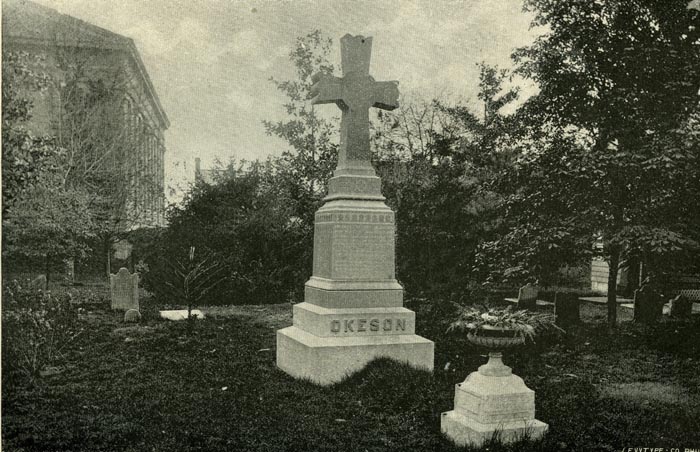
Okeson Monument, St. Paul's Churchyard.
To his loving culture are we greatly indebted for the present beautiful surroundings of old St. Paul's, though perhaps more for the rarer and lovelier blossoms and fruits that grace the hearts of many who so loved and honored him that his memory still lingers with them as a hallowing influence.
In 1836 by a city ordinance this old God's acre was closed to further interments, and since then our city fathers have, by special legislation, made but three exceptions to this rule. An esteemed and venerable lady, Mrs. Collins, who spent her youth in a long-past day and generation, having passed her four-score and ten years, was the first to be allowed this privilege, about a score of years subsequent to the enactment. In 1859 the old soil had again to be broken to receive the body of Mrs. Mary Chandler, aged ninety-one years and five months, a daughter of Col Anthony Lawson, who had been one of the feoffees of the towne of Norfolk. Once more the privilege was extended, in 1882, a graceful and grateful tribute to him whose honored name and work from March 1856 had been fully identified with this sacred spot.
Here rests within the shadow of the sacred walls and one of the stately elms, whose rapid growth he had lovingly marked from almost a mere twig, as the lively sparrows flitted between its new branches and her aged eaves, all that could be retained of this honored and revered pastor of old St. Paul's. A fitting tribute, a cross of polished granite (how truly emblematic!), marks the head, while loving hands keep the mound decked with bright and beautiful flowers. The little ones, too, have placed a graceful vase at its feet. Oh, how they all loved him!
[153] "It is the Night:
He sleepeth well beneath those soft gray skies
After the fight.
The night is come upon him, and he lies
Wrapped closely from all earthly sound or sight
In God's still night."It is the Day:
No more sad watchings by the midnight sea,
No twilight gray,
But crowned with light and immortality,
He stands from henceforth triumphing alway
In God's own Day."This burial, we hope, ends the chapter of interments; and this ancient resting place of our honored dead should now become a sealed book.
But we must not leave the old church without the mention of another, who loved and labored for this old sanctuary. He was a layman, who had passed to his honored rest, while his pastor was still vigorous at his post of duty; so we will let him, who can so much better do it, tell the story as he did in a sketch of the old church given his people in June, 1877:
"Of one (once of our vestry) now at home and at rest I reverently venture to speak His name should be inscribed somewhere within these walls—for without his unfaltering devotion and generous care this church could not possibly have been sustained during the long years of its infancy and weakness. It is simply to utter what is now a plain fact of history to say that no layman has ever done so much for St. Paul's church as did the late William W. Lamb."
Man calls Time the ruthless destroyer, but Time has touched lightly these honored walls, and sought only to decorate them with the beautiful, clinging ivy, fit emblem of that tender, faithful love which was last at the cross and first at the grave. It is the vandalism of man that has proposed to touch these sacred walls and to enlarge this sanctuary to gratify ambition. Touch them not, dear friends—put no new patch in this revered old garment—for, leaving out the question of sentiment, rest assured the skill that erected this old edifice was better posted in acoustics than we, and any attempted enlargement could only result in flat failure and merited discomfiture.
"On it, Time his mark has hung;
On it, hostile balls have rung:
On it, green old moss has clung:
On it, winds their dirge have sung.
Let us still adore thy walls,
Sacred temple— old St. Paul's!"
St. Paul's. — North Entrance.
As already stated, the substantial walls of old St. Paul's were the sole survivor of Lord Dunmore's revenge, taken on the first day of January, 1776; and for nearly a quarter of a century, during which the old towne [154] was being rebuilt, we find no account of the rebuilding of houses of public worship.
The earliest record on the subject states that in 1800 the Baptists were worshiping in a house on Cumberland street, just across from the building erected in 1816, from which they removed to old St. Paul's early in 1801 and continued there for about fifteen years, when they occupied their new church, which was then described as a neat, plain and commodious brick building. We present a picture of this First or Cumberland-street Baptist Church (page 77) as it now stands, enlarged and greatly improved, until it exhibits a chaste and attractive front.
Internally it has undergone, we are satisfied, such wonderful changes that were it possible for one of the old worshipers to return he would scarcely recognize his old church home. From this mother church sprang the Freemason-street church, of which mention has already been made in our historical sketch, as a work of pious, self-sacrificing men and women which was an honor to their denomination, a credit to themselves and an ornament to the town. On page 27 will be found a view of the church as it now stands, its symmetry somewhat marred by the loss of the graceful spire which went down in the storm of 1879.
How the good work has prospered is shown by the flourishing condition of the first church and this its eldest daughter and a family now augmented by the thriving third church in the northern portion of the city, one in Brambleton or East Norfolk, and still another in Atlantic City.
In close proximity to her Baptist sister, their enclosures both fronting on Cumberland street and touching in their rear the old God's acre of the towne, stands the large and substantial edifice of the Methodist Episcopal Church, the oldest of this denomination in our city. In 1800 they were worshiping in an old building on Fenchurch street, south of Holt street, which is now numbered among the things of the past. In 1801, however, they had erected a substantial and comfortable church edifice, which occupied the site of the present building. This gave place in 1833 to the large and commodious building shown in our cut on page 51, which was dedicated in that year by Rev. Dr. W. A. Smith, who was the prime mover in its building. It still stands, imposing as an ancient temple, and, though somewhat changed within to comport with more modern ideas, gives a sheltering fold and welcoming heart home to many a "weary and heavy-laden" one who seeks rest at the Master's bidding. Its daughter, the Granby-street Church (as shown on page 61), has graced the corner of Granby and Freemason streets since 1850, where it was built after very arduous labor in securing a foundation by piling. Once built, however, it has continued to be well supplied with worshipers—and those too who have been both willing and able to spend freely as well as to be spent in the Master's service. There are, we have been informed, four other edifices for worship belonging to this denomination in our city and [155] its suburbs, which have been erected or are being built through the instrumentality of this church from centenary contributions.
In 1800 occurred that unfortunate controversy in the old Episcopal Church, to which casual allusion has already been made, resulting in the greater part of the congregation leaving the old building and worshiping in the Town Hall under the ministration of Rev. J. Whitehead until the new church was completed in the next year, on the east side of Church street, just opposite to the old churchyard. This church, however, was destroyed by the great fire of 1827, and the new site was chosen for the new church—Christ Church—which was built during the next year, and still stands, on the corner of Freemason and Cumberland streets, as shown on page 44.
Its familiar face will be recognized with love and pleasure, no doubt, by many an old worshiper within its hallowed walls, whose homes are now in distant climes and amid other scenes. Its congregation continues one of the wealthiest and most influential in the diocese of Virginia, and loves its old home well. Its architect and builder, Mr. Swain, of this city, received general commendation for his work, and our venerable Bishop Meade in his work on the "Old Churches and Families of Virginia" was lavish in his praises of its internal arrangements.
But times have changed, and our Virginia congregations are changing with them; and while this church is certainly very attractive within in its more modern guise, we doubt whether our good Bishop, could he return to the scenes of his former labors, would pronounce so decided and favorable a verdict on the subject. St. Luke's, a comparatively new and flourishing congregation, came originally in great part from Christ Church, but has now been greatly enlarged by new material, and found it necessary to extend and improve the Guild Church, which they first occupied.
This denomination has also Emanuel Church, in the northern section of the city, and a new and flourishing congregation who worship at St. Peter's in the east or Brambleton ward of the city.
A good work among the colored citizens was inaugurated some five years ago by the rector of St. Paul's, under the auspices of his auxiliary society, or St. Paul's Brotherhood, as it is now called, resulting, with the assistance of the other Episcopal churches, in forming a very thriving congregation, who worship in the Church of the Holy Innocents.
The rector of Old St. Paul's, aided by this same brotherhood, has now thrown the old church open every Sunday night for a people's service, specially designed for the churchless or spiritually homeless; and there is a reasonable hope that, under the divine blessing, great good will result therefrom.
Before leaving the Episcopal Church we must call attention to a well-known institution which, though not under the charge of any denomination, fell heir after the Revolution to that beautiful lot some 400 feet [156] square, situated on the corner of Bank (formerly Catharine) and Charlotte streets, which was originally set apart as a church glebe and was intended as the location of a rectory for Old St. Paul's. So long ago as 1806 we find mention of the Norfolk Academy, and at that date our late eminent townsman, Governor Tazewell, was among the trustees. Early in 1815 we find the origin of the "Slaughter" fund—$3,000 left as a perpetual fund for the education of several poor boys in reading, writing, navigation, etc. These boys were to be properly equipped and bound to the commander of a vessel of war or some discreet master of a merchant vessel, and their places at school, as soon as vacant, to be filled by others. This fund has been faithfully applied through the Norfolk Academy, thus securing proper education each year to some worthy recipient who might otherwise have lacked the opportunity.
A little incident in connection with this fund, as showing the good that is really found in our fellow-man, we think well worth repeating.
Philip Root Thompson, of Culpeper county, one of the heirs, called at the office of an eminent legal gentleman, some years since, in our city, and asked if there was not a technical defect in Dr. Slaughter's will which completely annulled the educational bequest and gave him a legal title to the amount set aside for the purpose. He was answered affirmatively. Much to the surprise of the attorney, who was just beginning privately to bemoan the loss to the good cause of education, he was requested to draw up an instrument confirming and establishing the devise beyond cavil and any future contingency. The instrument was promptly prepared and duly signed, sealed and delivered.
Mr. Thompson then asked his counsel to state the amount of his fee, and was told in reply that under such circumstances there was no charge, and more especially as only a few lines were required to accomplish the object desired. Kind reader, we fear the popular verdict of to-day would be "A pair of cranks!" The client, however, was not satisfied, but threw down several pieces of gold, left the office, and could not be persuaded to return and take them back.
It was not, however, until 1840 that the present elegant structure of the Doric order, modeled from the temple of Theseus at Athens, was erected in the centre of the old glebe lot. The building is 91 feet long by 47 broad, with a handsome portico at each end, with six symmetrical columns, and from the size of the lot has that great desideratum an ample play-ground, which is often sadly missed by our city schools.
This building is probably one of the few to be found in our midst of a pure architectural style, and was long thought by many residents and visitors of taste to be of rare architectural beauty. In fact, to think otherwise, in our school-boy days, of the "old penitentiary," as we fondly and jocosely termed it, would have been regarded as next to the unpardonable sin and the grossest treason. In truth, our feelings are still [157] lacerated by the contemptuous manner in which we were not long since addressed, by a boy of the period, on the subject of removing this old "eyesore" and building in its place a modern High School.
Diagonally across from the Academy will be seen a building still used for church purposes, as it has been for a half-century or more, by the African Baptists. It seems to be now in a sort of chrysalis state; much of the old brickwork is still standing, but new and lofty windows with modern stained glass have usurped the places of the old-fashioned broad ones with brick arches surmounting them, and the old familiar belfry that marked the Old Bell Church, so well known to every inhabitant, white and colored, of our city, has given place to a substantial tower, which doubtless has still higher aspirations. But for its location the old inhabitants would hardly recognize this old landmark of another generation.
This was the church edifice originally erected in 1802-3 through the efforts of that earnest worker Rev. Benjamin Grigsby, the father of our late eminent townsman, that accomplished scholar and historian—Hugh Blair Grigsby.
The cost of this church was $12,000, all of which was subscribed, as shown by the original subscription list now in the possession of the First Presbyterian Church, and paid by persons in Norfolk and its vicinity. This church, by the way, is the oldest of its denomination in the State, and one of the oldest in the country, as the records indicate 1683 as the date of its establishment.
The building to which we have just alluded was the first place of worship erected by the denomination subsequent to the general destruction of church property and individual homes already referred to as "Dunmore's revenge." Mr. Grigsby, its first pastor, continued to serve most acceptably and efficiently until he fell a victim to the yellow fever which visited our city in epidemic form in 1810.
In 1836 the present sanctuary of this church was completed, and on November 20 of that year it was dedicated by the Rev. Dr. Plumer.
This building was very much admired at that time, but since has been greatly improved internally and externally, from time to time, until it presents outwardly the very handsome and attractive appearance shown on page 33. It is located on Church street, opposite to old St. Paul's, on the former site of the Episcopal Church built in 1801 by Parson Whitehead's congregation of seceders.
The venerable Dr. Geo. D. Armstrong has been the beloved pastor of this flock since the spring of 1851, and has ably and zealously ministered during this period of 37 years. He is the Nestor among our city clergy in all evangelical works.
The steady and sure progress of this denomination is shown by the facts that it became necessary in 1872 to organize the Second Presbyterian Church, which now has a thriving congregation in a very attractive build- [158] ing on Freemason street; that the Atlantic City Mission was organized into a separate Church in 1882, and the Brambleton Mission in 1884 into what is now Park Avenue Church, of East Norfolk.
As noteworthy, we may also mention the Church of the Disciples of Christ on Freemason street, between Brewer and Bank streets, which is opened every Sunday to a large congregation of devout and earnest worshipers and presents a very inviting appearance. It is comparatively new, having a few years ago superseded the wooden structure on Charlotte street, which was occupied soon after the war by this denomination.
Certainly the handsomest church edifice in our city, with its graceful spire towering high into the clouds, and one whose interior will compare favorably in its beauty with any in the land, is St. Mary's of the Immaculate Conception, which, as its name indicates, is the shrine of the devotion of our Roman Catholic friends. This church was built some few years before the war, in a great measure through the earnest endeavors of the Rev. Matthew O'Keefe, who had endeared himself to many, of his fellow-citizens outside of his flock by his devoted services during the pestilence of 1855.
This building stands on the corner of Holt and Chapel streets, facing the latter, and occupies the former site of the small wooden chapel on the street, which in consequence now bears that name, and its surrounding cemetery. This wooden chapel was superseded in 1842 by St. Patrick's, which fronted on Holt street 50 feet, running back 96, and in fact still stands just in the rear of St. Mary's. It was considered at that time a very handsome building, and perhaps may be now by some of the old school; but nothing has more changed in our day than architectural taste.
Nor must we forget the two flourishing synagogues of our Hebrew brethren—the one of the old school, in the care of Rabbi Levy, on Cumberland street, just over the way from the old glebe land, where our Norfolk Military Academy, with its incipient heroes of the next war, now stands; and the other, of the Reformed faith, Dr. Eberson, Rabbi, standing on Church street, near the head of Freemason.
In our reference to the First Presbyterian Church we alluded to the fact that its old quarters, once the well-known Bell Church, were still occupied by the African Baptist Church, now known as the Bank-street Church. In addition to this we find two flourishing churches—the Queen-street Church, to which Dr. Richard Spiller ministers, and the First Church, in charge of Rev. David King, besides two other less important congregations, all belonging to this denomination.
The Methodists are largely represented also in our colored churches, and have no less than seven substantial and commodious edifices for the purposes of public worship.
The largest church edifice erected by our colored people will be, however, the St. John's A. M. E. Church, situated on Bute street, near Church [159] street. The corner stone of the new church, now being built on the site of the old one by Messrs. Tee & Brittingham, was laid April 16, 1888. Under the supervision of Mr. Cassell, one of our city's excellent architects, the work is being rapidly pushed and will be completed this year, making a very handsome addition to the architecture of this part of the city. The main auditorium will have a seating capacity of 1,500 people, with a basement divided into lecture, class and committee rooms. Much of the recent prosperity of this church, we are reliably informed, is due to the energy and zeal of its present pastor, Rev. W. D. Cook, formerly of the North Carolina Conference, who is now serving his third year with this church.
Church Edifice of the A. M. E. Church
( Erected 1888),
Bute Street, Norfolk, VA.
Rev. W. D. Cook, Pastor.He is a striking illustration of what can be accomplished by having "the right man in the right place."
Rev. W. D. Cook, Pastor A. M. E. Church.
Leaving this special church behind us—in fact, dropping the further consideration of churches in general—we now reach, with the intersection of Bute and Church streets, an object of great interest to all and one that may be considered at least as legitimate fruit of our Christian civilization irrespective of creed or sect. We refer to that elegant establishment the Hospital St. Vincent de Paul, so superb in all appointments, and where comfort and health, so far as skillful attention and good nursing can secure them, are sure to be found. Before the late war, in the midst of beautiful grounds here stood the handsome residence of Dr. James Behan, a Catholic gentleman—in truth one of nature's noblemen—which had come to him from his uncle, Walter Herron, a gentleman of wealth and most excellent repute in our community.
This handsome property upon the death of Mr. Behan, subsequent to the late unpleasantness, came into the possession of the Roman Catholics for hospital uses. Year after year have improvements been made, until it is nearly complete in all its departments. We refer the reader to page 13 for a view of its exterior attractions. To the internal comforts and luxuries of this institution—which should surely be a source of pride to our community, who have most generously contributed to aid the devoted sisters in making it what it is—the poorest and humblest, who have freely [160] enjoyed its hospitalities, or those of the most liberal means, who have been able to give a quid pro quo for all that they desired to tempt their failing appetites (and their name is legion), will cheerfully join in the strongest testimonials.
But the energies of our good people in this laudable direction have not rested here. Whatever may be said about the pokiness and slowth of our old "fish-and oyster-fed" borough in matters of business (and we hope that day will soon be numbered with the irrevocable past), our citizens with the good women, Hebrew and Gentile, ever in the van, certainly do not lack enterprise in good works. Our elder people may probably yet recall that beautiful spot in the eastern section of the city, on Holt street, that was known as Reilly's gardens. More recently, but still in antebellum days, the estimable owner and all his belongings having passed from among us, the Female Collegiate Institute, in charge of the Rev. brothers Smith of the Protestant Episcopal Church, flourished down to the very outbreak of the war. Since the war St. Joseph's College, under Roman Catholic auspices, also here had its seat, until recently they found it best to part with this charming location. Opportunely a plan for establishing a Retreat for the Sick, free from sectarian or ecclesiastical control, had been consummated, and a benevolent association, composed of good people from all Protestant denominations, as well as many of our worthy Hebrew citizens, purchased this admirable location, and now most earnest efforts are being put forth to have everything arranged at an early day to provide fully for the comfort of the sick and needy.
In addition to the care for the sick, the desolate orphan finds a home provided by the Roman Catholic Church at St. Mary's Female Asylum, or the Jackson Female Asylum of the Protestant Episcopal Church, or again the City Female Asylum of the United Protestant Churches, while the boys are carefully looked after in the Orphan Boys' Home. The Episcopal Church has also provided a Home for aged, infirm and indigent females.
Nor can more admirable institutions be found anywhere than our "United Charities," which has concentrated and systematized the work of benevolence so as to do the greatest good to the greatest number and just when most needed, and "Woman's Work Exchange," which gives a ready and pleasant outlet for the energies of many a needy but perhaps modest, shrinking woman.
We have the Seamen's Friend Society also, with their Bethel right down near the shipping so as to best reach that class of men and tell them His story, whose wonders they have seen in the great deep.
Our Catholic citizens are well represented in three beneficial societies that do most excellent work, not the least of which is the preservation of temperance and sobriety. In fact, each of our churches has its special band of hearty, earnest workers, much of whose good work is known only [161] to that common Father that seeth in secret, and who shall yet reward them openly.
But before leaving the subject of the doings of earnest Christian workers we must not fail to mention a most creditable work that has been recently inaugurated among our colored citizens. The deplorable moral and physical condition of many colored young men in our midst and the injurious effects sure to follow throughout our city caused serious alarm not only to the clergy hut to the business men, both colored and white of our community, which led to meetings, joint and separate, during the year 1887, for a prayerful consideration of this serious subject.
The International Committee of the Young Men's Christian Association were appealed to and sent one of their traveling secretaries to co-operate in the general effort.
The result was the organization, early in 1888, of a colored Y. M. C. A., with a full board of directors, selected from our best colored men of various avocations, and an advisory committee of white citizens, composed of several of our leading pastors and laymen equally prominent in good works and the busy walks of life. This body has been ready at all times to give, when needed, the benefits of practical business and religious experience.
Mr. J. S. Smithson, a noted Englishman and sojourner in our midst, gave $400 towards the first year's expenses. The colored people pledged over $600 towards the same, and their pledge has so far been faithfully kept, and at no little sacrifice, while the advisory committee have undertaken to raise an equal amount among our white citizens.
An admirable general secretary was secured—a young colored man of remarkable intelligence and fine education, who voluntarily left a lucrative situation which he held for life or good behavior under Government in Canada, and an assured social position which he was well advised he could not possibly hold in this latitude, to come into our midst and enter upon his Master's work among the men of his own race.
We give, therefore, justly, we think, a place among the moral, or rather Christian, heroes of our day and generation to W. A. Hunton, the general secretary of the colored Y. M. C. A. of Norfolk.
We note this as the pioneer organization of its kind in our country, and the result, which has been watched eagerly by Christians throughout our land, has been most favorable.
After four months' existence its beneficial effects can be sensibly noted, and with its future development there is little doubt they will be proportionately enlarged.
For the present, rented rooms, suitably located, have been secured on Church street; but a movement is on foot, which has met with deserved encouragement at home and abroad, to purchase an eligible lot and erect a building adapted in every way to the uses of the association—an admi- [162] rable feature of which, we note with pleasure, is an Employment Bureau, that will be an antidote, we hope, to much injurious idleness.
The worthy president of our admirable Y. M. C. A. is one of the advisory committee, and will do all in his power to keep alive in his own association that cordial Christian interest that should be felt in so good a work.
Again, there are many who, not perhaps within any recognized fold of worshipers, may wish to seek an opportunity of doing good to their brother man, or in the fold may seek to supplement the church's work, and these find ample outlets in the many benevolent secret organizations that abound and flourish in our midst—noteworthy the Masonic order, in its various degrees, whose beautiful temple we referred to at length in our historical review, at the period of its completion and dedication.
The ancient I. O. O. F. flourishes also in our midst, with its handsome and extensive hall on Church street, containing not only lodge rooms but our only theatre for many years, and still a favorite place of resort for those seeking recreation or amusement. The Pythians, Heptasophs and Red Men and other similar associations too numerous to mention have their castles and halls in our city, and seem to prosper and do much good and useful work.
Our Hebrew fellow-citizens, who form a large, intelligent and influential element in our city's progress and prosperity, are not only connected with the several orders above referred to in positions of honor and trust, but have of their own special faith four flourishing lodges representing three well-known orders—the I. O. B. B., the O. K. S. B. (with two lodges), and the Free Sons of Israel.
But before leaving the subject of these secret benevolent associations we will take the liberty of giving a brief history of one of comparatively recent origin, that yet gives promise of great usefulness by its deeds of loving kindness and benevolence, and is certainly conspicuous in its regard for and tender memory of its beloved dead.
We refer to the B. P. O. Elks, a secret organization composed of members of every vocation in life. The foundation of the order is on the axiom " Do unto others as you would have them do unto you." The motto is, Charity, justice, brotherly love and fidelity. The objects of the order are explained in its motto.
At a meeting of a number of persons connected with the dramatic profession, in the year 1867, in New York city, the question of establishing an order in the profession which would prove beneficial to its members was discussed. The matter was placed in the hands of a competent committee, and on February 16, 1868, N. Y. Lodge, No. 1, B. P. O. Elks, was instituted at Military Hall, 196 Broadway, New York, by Charles Vivian, the founder of the order.
The Grand Lodge was formed, and held its first meeting February 13, [163] 1871, in New York city. For a long time the membership was confined strictly to the profession, with but one lodge in existence—N. Y., No. 1. After a time Philadelphia Lodge, No. 2, was organized, and the founders of the order began to see the necessity, for the good of the order, of soliciting members out of the profession, and also to extend the order by branching out in other cities. Members of the press were first called upon, and then all good men, regardless of their vocation. Lodges were introduced in all of the larger cities.
Norfolk Lodge, No. 38, was instituted November 29, 1886, with fifty charter members. It has to-day a membership of two hundred.
During the existence of the order in Norfolk, though but a young lodge it has taken a place in the front ranks of secret organizations—not that they claim any superiority over their sister orders.
Their motto is their guide—charity, justice, brotherly love, and fidelity. The first is dispensed without ostentation; the second is given to all; the third is that which all owe to each other, and the last is a combination of the whole.
While caring for the living they have not forgotten to provide for their dead. In Elmwood Cemetery they have a beautiful burial plat,- where a monument and statue mark the graves of their departed brothers, and we take great pleasure in presenting our readers with a handsome illustration of this beautiful memorial.
Monument in Elks' Rest, Elmwood Cemetery, Norfolk, Virginia.
But perhaps we have dwelt too long on the old landmarks and the softer attractions of the city by the sea; and lest we weary our kind readers of this "gilded age" with this unproductive and unprofitable (?) talk, we will turn once more to matters of facts and figures.
And we can find no better opportunity of showing the financial condition of our city and no better way than by making the following extract from the message of Mayor Barton Myers made to the Councils November 1,1887:
The Treasurer's report shows the bonded indebtedness of the city on June 20—
Registered and coupon bonds (not water bonds) $1,832,398.40 Water bonds Total Less cash on deposit in sinking fund, to be applied to redemption of registered bonds, which mature July 1, 1886 Leaving actual amount of bonded indebtedness Increase since June 30, 1886 Amount for redemption of registered and coupon bonds, other than water bonds, in the custody of the Sinking Fund Commissioners [164] For redemption of water bonds Total sinking fund (see Commissioners' report) Balance in bank at commencement of fiscal year Income for the year from various sources of revenue (not including water department). Proceeds of sale of bonds Proceeds of lease of Parker st Paving assessments collected from various streets Proceeds of notes discounted in anticipation of revenue to be
collectedTotal receipts Payments for the year, on account of appropriations to the several departments, for what may be termed running expenses of the city (not including expense of public schools,
which is given below in separate item)Interest paid on bonds and notes Paid for opening street north of Queen, between Smith and
Church streetsSewerage on Shields street Brewer street, grading, guttering and curbing Freemason street, drain Balance paid on station house New school house on Cumberland street Sheds in public school yards Paid on account of house in Elmwood Cemetery Keeper's house at city stables Contribution to Charleston earthquake sufferers Contribution to Boys' Home Erroneous assessments refunded Centrifugal pump at pump house Repairs to old pump at sewer well Repairs to fire-engine house Deposited annually in sinking fund, for the redemption of
bondsNotes paid Expense of public schools Six per cent. reg. bonds redeemed from Citizens' Bank Balance in bank at end of fiscal year June 30, 1887 Total disbursements The assessed value of real estate is at present The assessed value of personal property Total value of real and personal, [165] not including Brambleton
ward, no assessment of that ward having been made"The charter allows bonds to be issued to the extent of 20 per cent, of assessed value of real and personal property The bonded indebtedness previously stated is The balance, to the extent of which bonds may be issued, not including Brambleton ward, is
"The rate of city taxes for the current year is $1.50 on the $100 for general purposes and 30 cents for water tax, making a total city tax of $1.80 on the $100, excepting in Brambleton ward, where the tax for general purposes is 70 cents on $100. This ward having been added to the city within the present year, it pays no water tax, and does not contribute to the payment of the interest on the present city debt for a period of fifteen years. In this connection I refer you to the act of assembly approved April 6, 1887, entitled 'An act to amend the charter and to extend and define the boundaries of the city of Norfolk,' a copy of which I send you herewith. By this act the limits of the city, which previously embraced 754 acres, have been extended, taking in what is known as Brambleton, with an area of about 340 acres, making the total area of the city about 1,100 acres. The act also extends the right to any portion of Norfolk county, upon a petition of twenty-five freeholders resident therein, to have an election ordered by the Circuit Court, and vote to annex such territory as may be defined in the petition to the city of Norfolk, on the same terms as are extended by this act to Brambleton, the Councils of the city consenting thereto."His Honor estimates the present population of the city in excess of 30,000. He refers specially to the necessity of improvement of the quality of the city water for summer use as a sanitary necessity, and calls the attention of the Councils to the filtration system in use in Washington city. A similar plant of sufficient capacity for our present demands would cost about $75,000. But as a full supply of water must be secured with a view to the future increase as well as the present demands, His Honor further remarks:
"I strongly recommend that before any expenditure is made for the filtration of the water from the present sources of supply, a careful experiment be ordered, to ascertain what supply and quality of water can be secured by artesian wells at different points and different depths in the neighboring country. No thorough experiment has ever been made in this direction, and yet there are isolated instances where most excellent water has been secured, the most notable instance being at the cotton factory in Atlantic City, where 20,000 to 30,000 gallons per day of pure, clear water is being pumped from a depth of 50 to 60 feet, through 17 2-inch pipes. While $50,000 to $60,000 for a filtering machine may furnish the city with a supply of water comparatively clear, we may yet [166] in a few years be forced to make large expenditures to increase our supply of water, whereas a less amount expended in a gangwell system of driven wells might accomplish a two-fold purpose by giving us clear water and an inexhaustive supply, unvarying alike in winter and in summer. There are no other means by which we can possibly hope to place the water department of the city in a position not to be subjected every few years to heavy expenditures to meet our increasing wants."
Acting upon this recommendation the City Councils made an appropriation of $500, which was expended in a pertinent investigation in the vicinity of the city and subsequently augmented by a second appropriation of $1,500, which will be similarly applied.
A series of very interesting and, so far as conducted, very successful experiments have been made by an intelligent engineer, Mr. Henry Knox, who is convinced that a supply of pure water will be obtained amply sufficient to meet the demands of our city, even when extended to its Lambert's Point limits.
While on the subject of city finances and improvements involving a necessary outlay of public money, the question of public schools is a pertinent one.
There are one primary and four graded schools for white children, not including the Fifth or Brambleton ward, and three schools for the colored children. The new and large school-house, erected at a cost of $10,000 for this race, on Cumberland street, is a very creditable building. In fact our public schools are well maintained and regulated, and certainly show some advance. When we consider, however, that our system of schools antedates the late war and that our city was the pioneer in this State in the establishment of the admirable institutions, and compare our schools with those of our sister cities, notably Richmond and Lynchburg, we fear that the comparison will show that we are behind in the race and have failed to maintain our well-earned reputation of other days. Certainly a High School, well equipped with all the modern instruments, is a felt necessity in a community of our size, wealth and social standing. Where, then, is the trouble? We are suffering, we fear, from that unhappy epidemic, so-called retrenchment and reform. Let us have reform in this respect by all means—but may a merciful Providence soon put a stop to this blind retrenchment—unless "ignorance be bliss" and therefore "it is folly to be wise," in which case we would suggest still further retrenchment in this unnecessary outlay for educational purposes. But if "an ounce of prevention is worth a pound of cure," and thorough education will put a stop to idleness and its offspring, vice, by all means let us squander (?) our dollars on education that we may save our dimes, that would else have to be spent on the punishment of crime.
Outside of this public provision for education our city can turn with pride to many at least of its institutions of learning, which have a high [167] reputation extending far beyond our city limits. Among these none stand higher than the Leache-Wood Seminary for girls and young ladies, whose attractive building will be found illustrated on page 20. Nor can a superior be found to the Norfolk College for Young Ladies, whose bright and beautiful alumnae are the peers of any literatæ in the land, and whose handsome quarters adorn our page 103. The old N. M. A. still holds its own as a boys' school—to say nothing of the many intelligent teachers scattered around in our midst, of real sterling worth and modest merit, who are doing good work. But we must not forget "Old Man Bill Dick" Galt nor the Rev. Bob Gatewood, both of whom are still engaged in training boys to take high positions in the counsels of our State and country.
Before leaving the subject of education we can but refer with pleasure though it may be mingled with a little sense of humiliation, to the handsome provision for the colored race in our midst which is shown in our illustration on page 46. This Norfolk Mission College is the benevolent work of the Northern Presbyterians in behalf of the race "that long in darkness pined." We are very fond of talking of the close fisted Yankees—and no doubt economical and close-fisted they may be in making and saving money—but they certainly know how to spend when they begin, and with a liberality and generosity too that sometimes put our freehandedness to the blush. We can discriminate between that benevolent cant that is all bosh and wind, and that professed faith which shows its reality in works; and when we see the genuine article, North or South, we appreciate and praise it without prejudice or fear.
But education, though a very essential element to true progress, must be backed by the sinews of war; and in the absence of ready capital or an insufficiency for extending a growing business, the banking facilities of a community get to be a very important factor in a city's growth. How, then, the question naturally arises, are we provided in this respect?
To this we give ready answer. One National Bank, with a capital of $400,000, and the grim experience of three years ago and its sad results, were they needed (?), pointing like an index finger to the motto, "Strict honesty and unwavering fidelity to your trust is the only highway to safety and continued prosperity." Four well-established State Banks, with an aggregate capital of $300,000, augmented by a surplus of some $150,000, and four Savings Banks, whose united capital will reach about $100,000. To which may be added a Private Bank of large means and business, which is a member of the Clearing House Association, and another, old and well established, but of more limited transactions.
These institutions are all regarded as solid to the extent of their business, and accommodating as far as consistent with the best business interests of all concerned, and have so far proved sufficient to meet the demands of trade in the present status of our business, domestic and foreign.
[168] Our five building associations also form useful adjuncts to the banking, capital, as they enable men of limited means to build homes or accumulate savings by small weekly payments, which would never find their way in the course of business to any regular banking institutions.
We have three Business Exchanges—the Norfolk and Portsmouth Cotton Exchange and the Merchants' and Manufacturers' Exchange, to both of which considerable reference has already been made, and the Real Estate Exchange—all of which are thriving and useful institutions.
We have also some eight representative Trade Unions, besides three lodges of Knights of Labor, all in harmonious operation, showing that our mechanics are fully abreast of the great issues of the day.
We should be perhaps accounted remiss if we neglected mention of the Press—that mighty lever in building up and pushing ahead the cities and towns of this great country of ours—and would like to speak in terms of unqualified praise of our enterprising townsmen of the "fourth estate," but candor compels us to say we do not think they have that influence and standing abroad, whatever it maybe at home, that the representatives of a city of our fancied or real importance should claim.
We have two morning and two evening dailies, it is true, to say nothing of numerous weeklies and monthlies, some really spicy and strong, and destined yet to exert a marked influence for good and progress—which is perhaps a supply in excess of the real demands of our population; and we have no doubt that one morning and one evening daily, eschewing the strength and bitterness of politics, perfectly independent, and advocating Norfolk and Norfolkians for the sake of Norfolk—as sometimes our Press have done in their best efforts—two real live and newsy papers with it all would secure a prosperity for the proprietors and a standing as journals that have as yet been unattainable by our local Press.
From the "press-gang" it seems but a natural transition to the "clubs"—social, we mean. The oldest, and one of the most prosperous, of these organizations (may we call it the Queen of Clubs?) is the "Virginia"—naturally the resort of the F. F. V.'s. It moved several years since from its original home on Main street, near the post office, having outgrown its old quarters, to new ones, in what had been one of the most elegant private residences of the city, situated on Granby street, at the intersection of Plume—now opened beyond. Since its occupancy of these new quarters, this neighborhood has certainly improved from a business point of view. The new building is elegantly arranged, with parlors and sitting rooms, illuminated by electric light and often by the flashes of wit—for its members and guests are among the brightest minds of the state and city. It has also a commodious reading room, well furnished with the best American and foreign journals and periodicals, while billiards and games of cards—only the strength of a friendly game, however, as gambling is strictly prohibited—and perhaps (?) an occasional quaff of some inspiriting fluid, are much in vogue.
[169] As might be expected, in Norfolk, the cuisine is excellent, and a well-trained body of servants is said to be a marked characteristic. This organization has certainly proved a social success in affording a hearty and home welcome to many a wanderer, at least, temporarily homeless.There is also the Hunter Woodis Club, composed, we believe, of gentlemen of Irish birth or extraction, all thorough good fellows and big-hearted fellow citizens, and fond of enjoyment of head and heart. Then there are the United Ocean Club and the Ocean Pleasure Club, which we know by their make-up are bound to give a good time to those who are so happy as to become their guests.
We come now to speak of two clubs or associations which, while perhaps claiming to be equally social in their nature, make their appeals as well to the head as to our other weak (?) points.
The Montefiore Association is entirely composed of Hebrews. It has its elegant quarters on Fenchurch street, opposite Falkland street, in one pf the largest buildings in the city, which is fitted up in unsurpassed style and beauty. Besides its club rooms, this association is the proprietor of the celebrated Montefiore Hall, in which the wealth, fashion and beauty of our city are wont to hold their elegant entertainments.
But we are disposed to give the Northern Club a preeminence and a more extended notice on account of the brilliant and instructive lectures on scientific and kindred subjects—as well as the lighter and, perhaps, more pleasing entertainments—for which our people are indebted to the enterprise of this club. Strangers, ladies not excepted, are always heartily welcomed and made to feel at home when visiting their rooms. Despite, therefore, of the rather chilling name, which might appear to be assumed to freeze off those who hailed from Dixie and the Sunny South, we think a perusal of the following extract from a recent address to the prominent citizens of Norfolk by a committee of the club will prove of general interest in showing its true intents and purposes, which are certainly calculated to prove of great practical benefit to our community:
"The Northern Club, of Norfolk, Va., is in no sense an exotic institution. It was founded in 1885 by business men, who were permanently located, and whose fortunes depended on the growth and prosperity of the city. For the past three years the club has been aiming to contribute, in a modest way, to the welfare of the community, and feeling its way as to the best method of making the city attractive to new comers. The stockholders now propose to prove their faith in the future of Norfolk by a very significant step. To promote the objects of the club, the erection is contemplated of a four-story building which shall be second to none among the architectural ornaments of the city. A suitable lot on the corner of Granby street and City Hall avenue has been purchased for $8,000, and the architect's plans approved.
"It is believed that the mere existence of such an edifice, on one of the most conspicuous sites in the city, and with such a distinctive name as [170] the Northern Club, cannot fail powerfully to impress persons of means who visit the city from abroad. It will prove that men born elsewhere have prospered here. It will prove that the advance wave of population from the rich and crowded centres of the North has not been repelled from the city of Norfolk by any Chinese wall of sentiment. Such a building will be a solid refutation of doubts as to the climate, or dismal tales about the impossibility of success in the South. The substantial walls, the interior attractions, and polite attention, with the well-furnished reading room freely open to strangers in the city, will create those favorable impressions which weigh so much when men of capital are deciding where to choose a field; and as nothing of the kind has been heretofore attempted in the South, it will be an unique advertisement of Norfolk over other Southern cities.
"The Northern Club is not, and was never intended to be, exclusively composed of Northern people. It fully recognizes that Southern names add greatly to its opportunities for usefulness, and the hearty cooperation of all is therefore invited in this effort to attract and hold desirable additions to the population of our growing cities."
Left: City Hall Ave. Front.
Right Street Front.
THE NORTHERN CLUB.Were any further evidence of the usefulness and benefits of this energetic organization needed, none better can be given than the handsome illustration we present on another page, from the architect's design of the new building now being erected at the corner of City Hall avenue and Granby street by the Northern Club. The lower story is to be used for stores; the second story is the public hall and lecture room; the third story is occupied by the club as library, ladies' parlor, smoking room, committee rooms, etc., and the fourth story contains billiard room and banquet hall. The edifice was designed by George C. Moser, our city architect, and is built of pressed brick with stone and terra cotta trimmings.
But we mustn't forget that class who have little spare time and less spare change, in whose behalf we have already raised our voices in earnest appeal to our City Fathers. We think the extension of our city railroad (which was completed to Brambleton in April, 1888, and has since been satisfactorily running to its terminus in the eastern ward) and the resumption of the route from our northern limits to the stables in Huntersville have certainly enlarged the limits of a comparatively cheap ride, thus giving some opportunity for recreation and fresh air to this class of our fellow-citizens, to say nothing of the benefit of giving us closer communication with that portion of the city so recently admitted and the northern section so soon to come in.
It is certainly most gratifying, while on this subject of the extension of the street railway, to note the rapid progress which the new company, the Suburban and City Railway, is making in laying the track from Market square, up Bank street to its termination at Queen street, which [171] it then traverses both in an easterly and westerly direction. When completed every part of the city will be brought in easy connection by rail with the other.
Apropos, however, of cheap amusements we note that long-headed little Dutchman John Lesner, who is a very prominent figure in county politics, has associated with his son and given the people "Maplewood Park," right on the line of the railway in Huntersville, with many attractions, wild and domestic, for a small consideration, and is already being liberally patronized, and will no doubt reap a large harvest—while our City Fathers supinely wait for something intangible to turn up. It will be a cold day when "honest Shon" gets left.
Those who are willing and able to take a little more extended trip for recreation will see in the rosy days of June our old familiar friends the Ocean View cars once more riding on the rail and that quiet and peaceful old favorite seaside resort opened again for visitors, though this time under a new management—which of course is prompt to promise better things, with new facilities for old enjoyments.
Club and private enterprise have united, moreover, to add new attractions to this favorite beach and its gentle surf, and it will no doubt continue to be the local centre of attraction it always has been.
There have been grand doings, however, at its more pretentious rival, VIRGINIA BEACH, which possesses the finest stretch of firm, flat sand on the Atlantic coast, and the noblest, safest expanse of real surf bathing in the world.
It is eighteen miles from Norfolk in a due easterly direction, and is easily reached over the narrow-gauge road of the N. and V. B. Railroad Co. in three-quarters of an hour—and the distance is soon forgotten at our first view of Old Ocean and his never-ceasing music.
The beautiful Hotel Princess Anne and this magnificent beach are both the property of the railroad company. The hotel has been completely rebuilt and is now most admirably equipped not only for summer but also as a winter resort. On June 1 the new management will begin their first summer season. It is prepared for the accommodation of 400 guests and is furnished with electric lights and bells and all the usual appurtenances of a first-class hotel. The temperature of the water averages 76 degrees in summer, is warmer and the bathing more prolonged than on the New Jersey or Long Island coast, while malaria or mosquitoes are unknown. The average summer temperature is 78°; that of winter, 54°—the extremes of temperature for the year being only about 34°.
There are ample mail facilities and telephonic communication with Norfolk. The Western Union Telegraph Co. also has an office in the hotel.
The amusements consist of surf and still-water bathing, crabbing, bowling, billiards and tennis, while a well-appointed boarding and livery stable affords the opportunity for horseback riding and charming drives [172] through the towering pine forest. Rowing, sailing and fishing on Lake Holly or Linkhorn and Lynnhaven bays, which adjoin the property of the company, can be enjoyed to the full by those who take delight in these manly sports.
At Virginia Beach, Lake Holly.
The far-famed "Sportsman's Paradise," the upper part of Currituck Sound, with its noted duck-shooting grounds, is of easy access, being only twelve miles to the south, over a good road.
In connection with the scheme for keeping the Hotel Princess Anne open all the year round we would note the fact that the subject of the advantages of tidewater Virginia as a sanitarium, especially during the winter months, has recently been brought to the notice of the celebrated Climatological Society in a very able and forcible manner by Dr. Alex. Y. P. Garnett of the National Medical College of Washington, D. C.
Dr. Garnett thus refers to this favored locality: "The whole of this region of country is composed chiefly of light, sandy soil, at one time almost entirely overspread by extensive pine forests, and although interspersed with rivers and creeks, whose shores are in many places lined by marshes, the cultivated lands and forests are remarkably dry and porous. These bodies of pine forests, besides affording protection from the cold winds of winter and spring, furnish a constant source of terebinthinate exhalations, which can be readily perceived at all seasons of the year, but especially so during the summer and spring. It has been a subject of common observation for many years, that persons affected with pulmonary consumption, when brought to the piney regions of this section and permitted to reside there for a long period, almost invariably improve in health and in many instances get apparently well. In view of the popular theory of the present day, one, indeed, almost universally accepted, that certain altitudes constitute one of the most important and efficient agents in the climatic treatment of this disease, these statements may seem somewhat startling and improbable."
An evidence of the mildness of the climate is the yearly immigration to this region of all the water fowl common to this continent, from the cold northern latitude, where they spend their summers hatching and rearing their young. The genus homo might have learned a lesson long before from the instinct of these birds, but it was not until the war had revealed its charms to soldiers from the North, who had never known such a climate, that this region was ever thought of as a place for winter residences or as a winter resort for invalids.
The advantage of this climate is caused by the close proximity of our sea coast of Cape Henry to the Gulf Stream, and the heat coming direct from it reaches our shore, besides warming the winds which sweep over it and bear to us its balmy influences and cause its eddies to touch our very shores.
[173] But besides our proximity to this heat-bearing current there is another most important and valuable circumstance which causes a more general distribution of its warm water on our shore than would be produced by ordinary eddies. The space between the Virginia Capes (Henry and Charles), only about ten miles, is the waste-gate for an immense body of water borne down to the Chesapeake Bay by the rivers of Maryland, Pennsylvania and Virginia. The Susquehanna, the Patapsco, the Severn, the Rappahannock, the Potomac, the James and the Elizabeth and their tributaries, which drain the immense watershed of these great States east of the Appalachian range of mountains, can empty their torrents through this narrow gateway only. So vast a body of water poured into the ocean through so narrow a vent must be forced very far out into the sea—so far, indeed, as to form no inconsiderable impediment to the outward northern flow of the Gulf Stream, and thereby causing more of an eddy than would otherwise be produced. This backing of the warm water of the great ocean-river at a point nearly, if not quite, opposite our Capes, is, we believe, the true explanation of the mildness of our climate. That it is not due to latitude is evident from the fact that it becomes colder the farther you recede from the seacoast. The winter isotherm of Norfolk, instead of following the line of latitude across the continent, rapidly dips toward the south and enters the northern part of Louisiana. A glance at any of the weather maps issued by the Signal Bureau will convince us of this and will show that we have in Norfolk, and Virginia Beach particularly, during the winter, the same temperature and climate as Shreveport, La.; but in addition to this we have the invigorating salt air from the ocean.The sanitary provisions and requirements of the hotel are perfect and efficient in every appointment and feature, consisting of a system of sewerage that has never failed to meet the full measure of all requirements desirable for health, comfort, convenience and safety.
In addition to the improvements and attractions added by the company a large number of our prominent citizens, as well as those of other localities, have purchased lots and are building fine cottages, thus greatly adding to the social attractions while they enhance the beauty of the surroundings of the Hotel Princess Anne. We present some beautiful illustrations of this charming watering place, but they fail to convey a tithe of its true elegance and beauty, which have to be seen and enjoyed to be fully appreciated.
